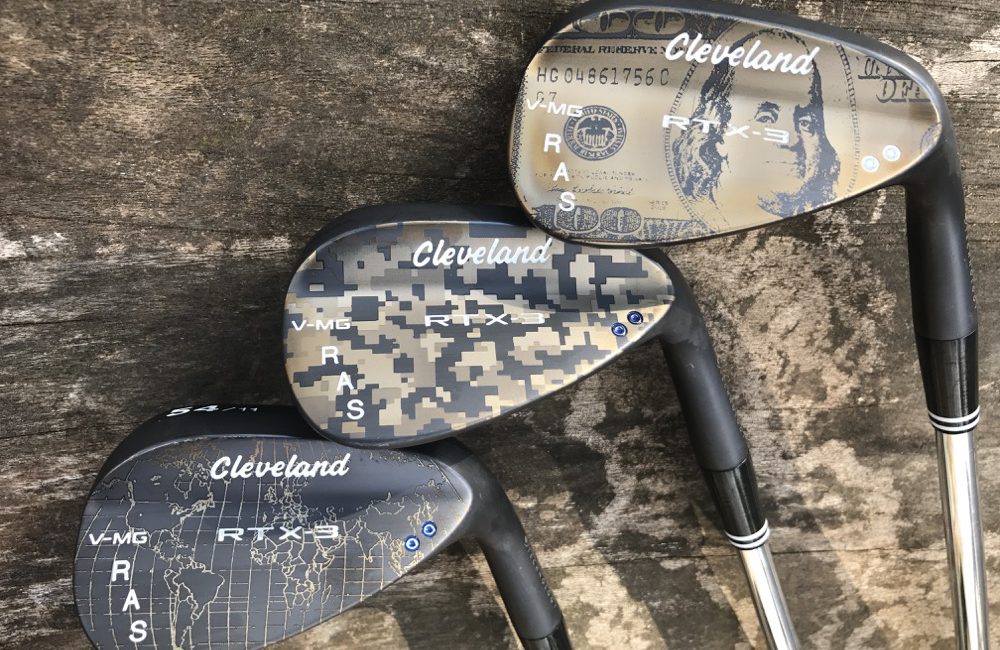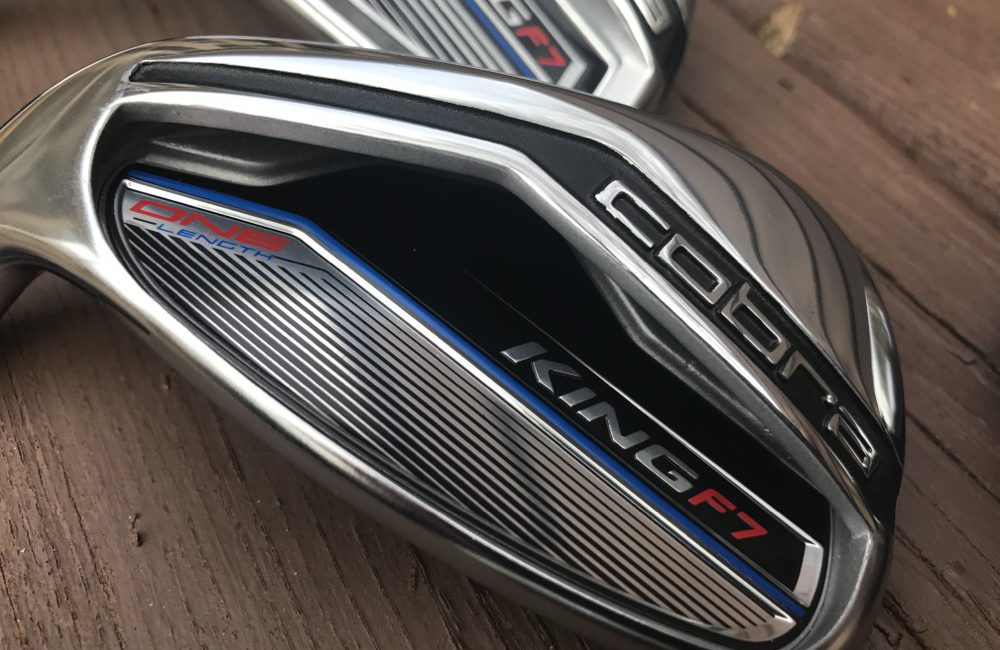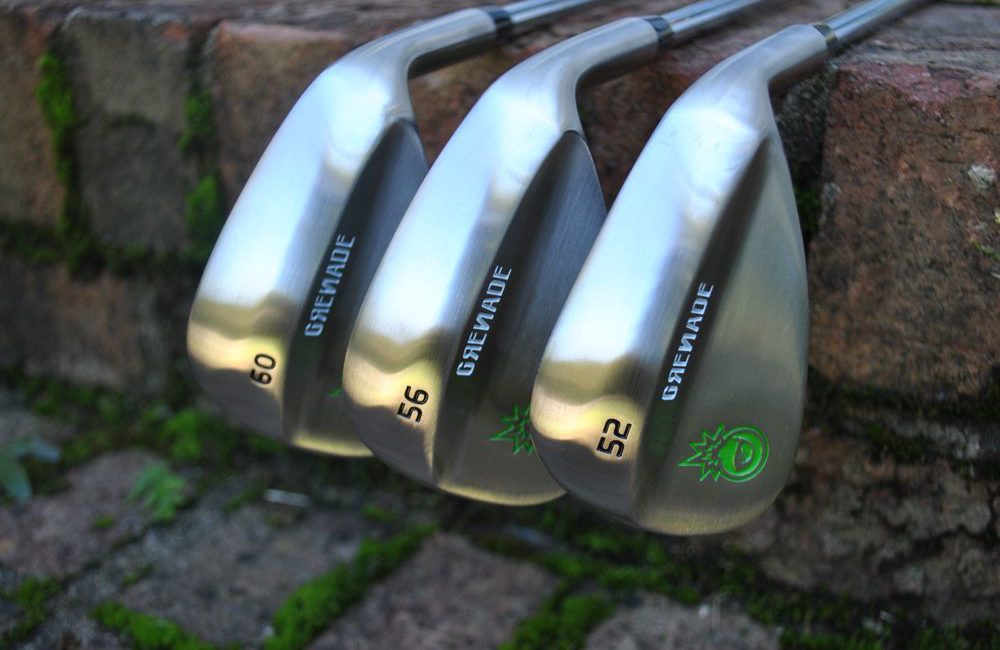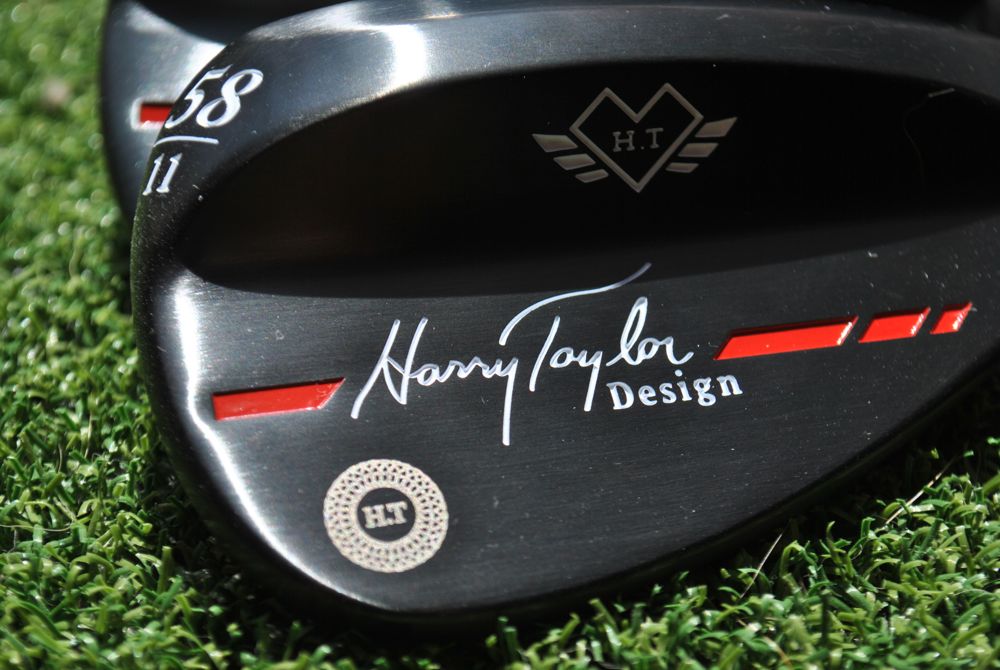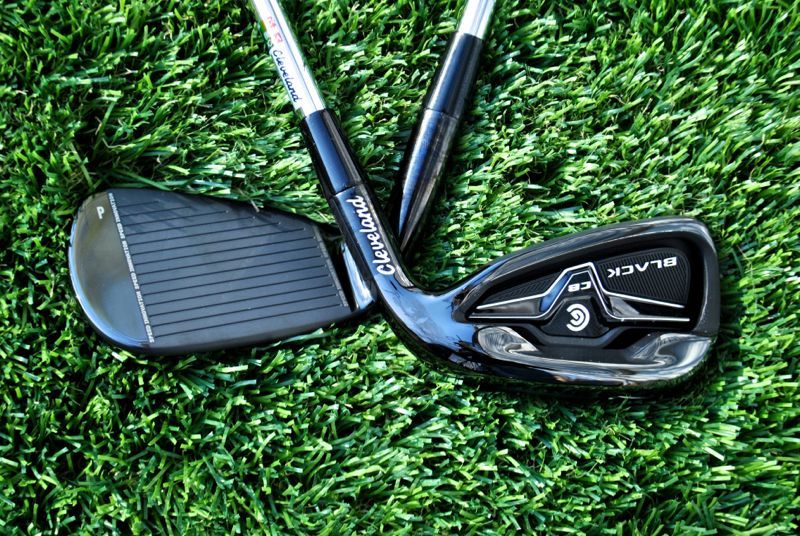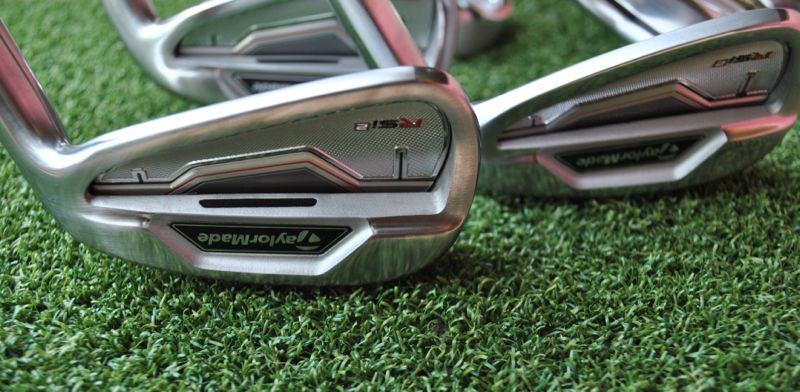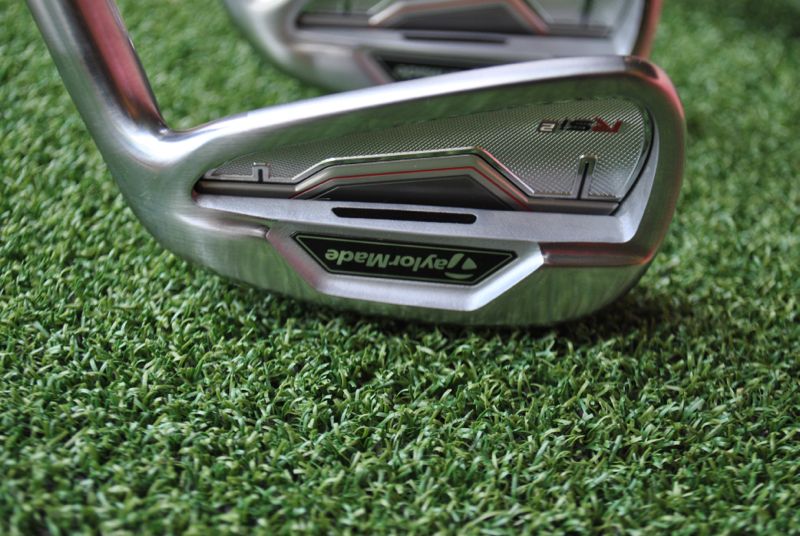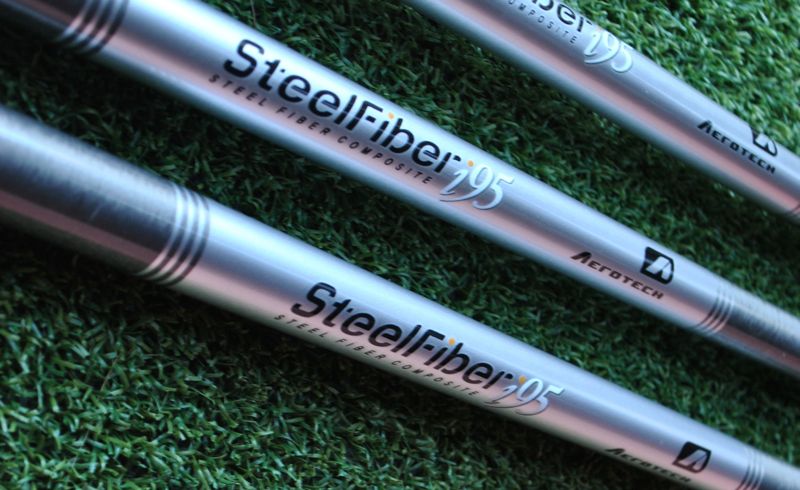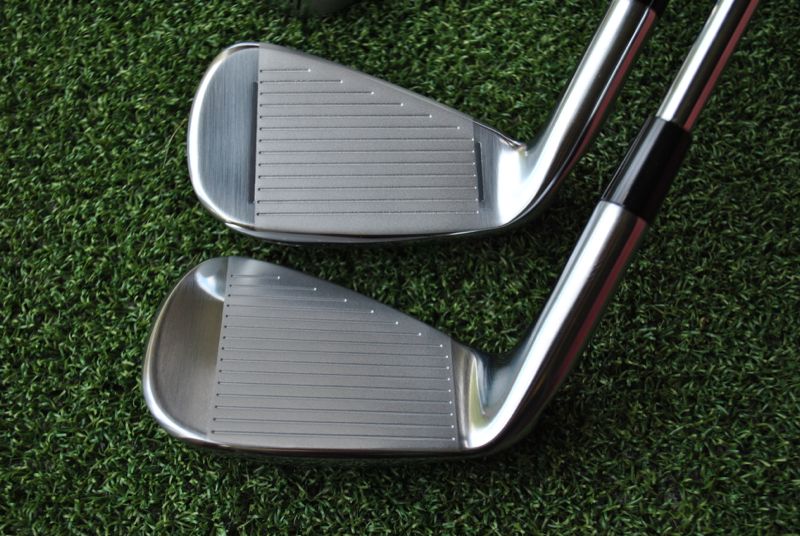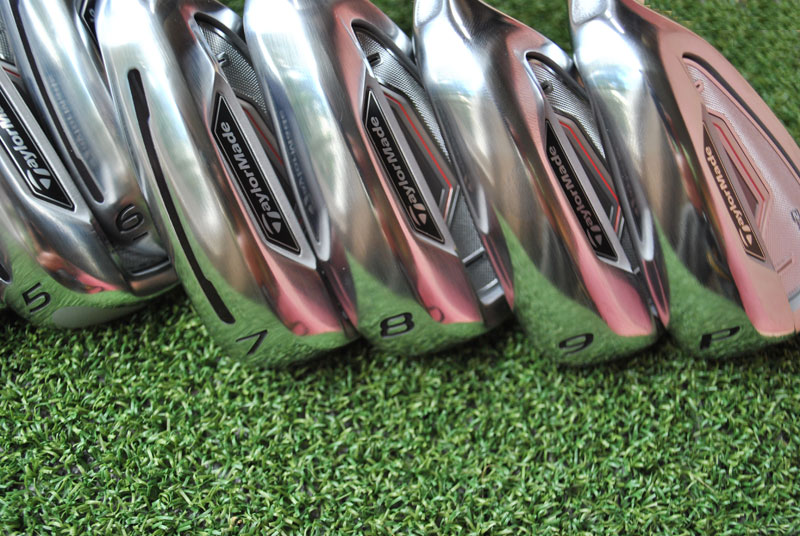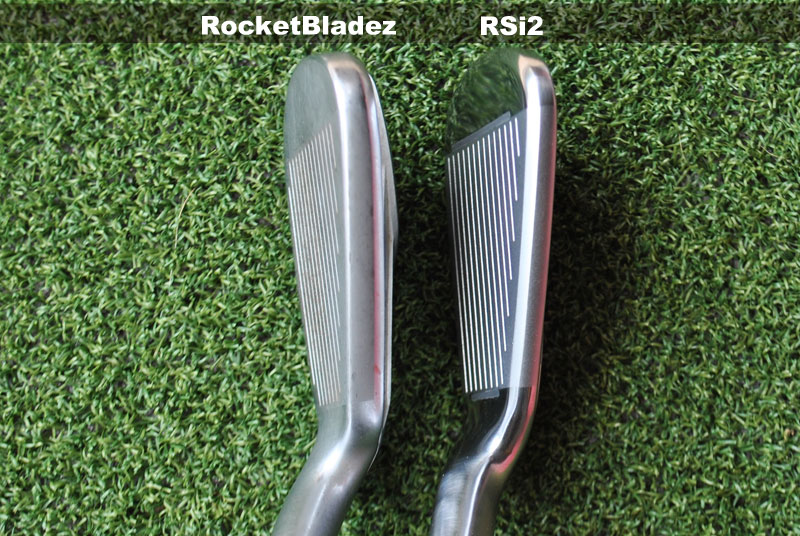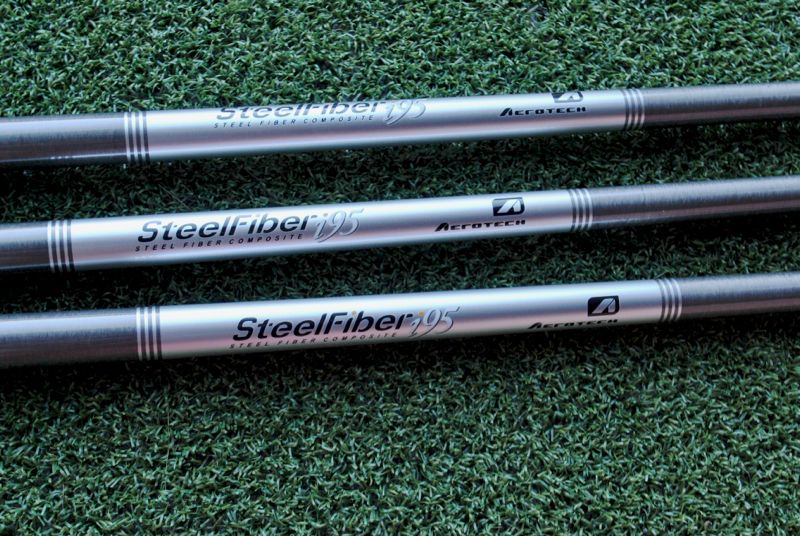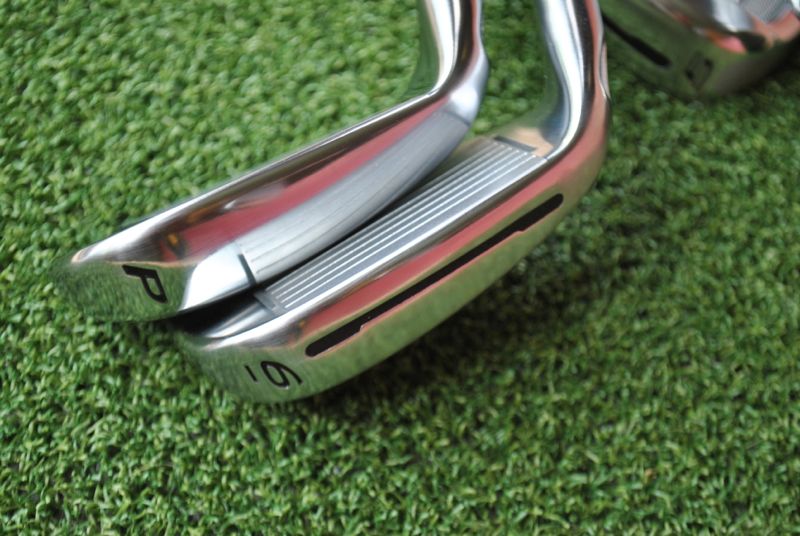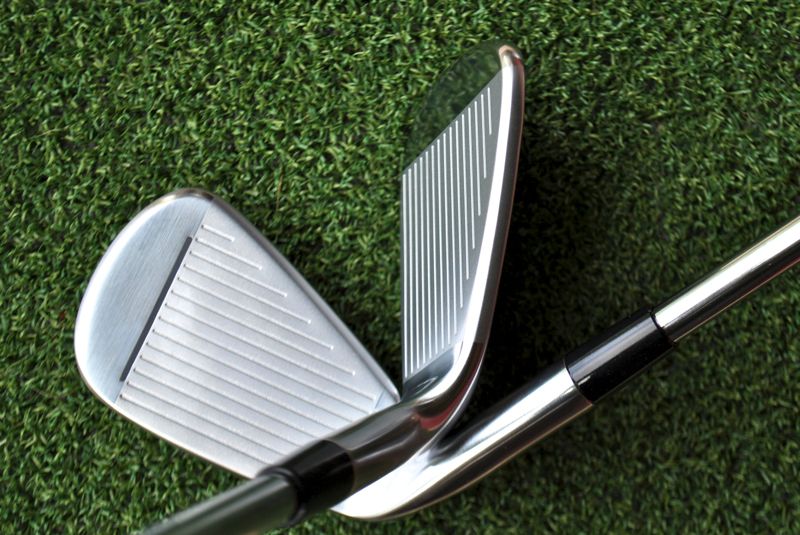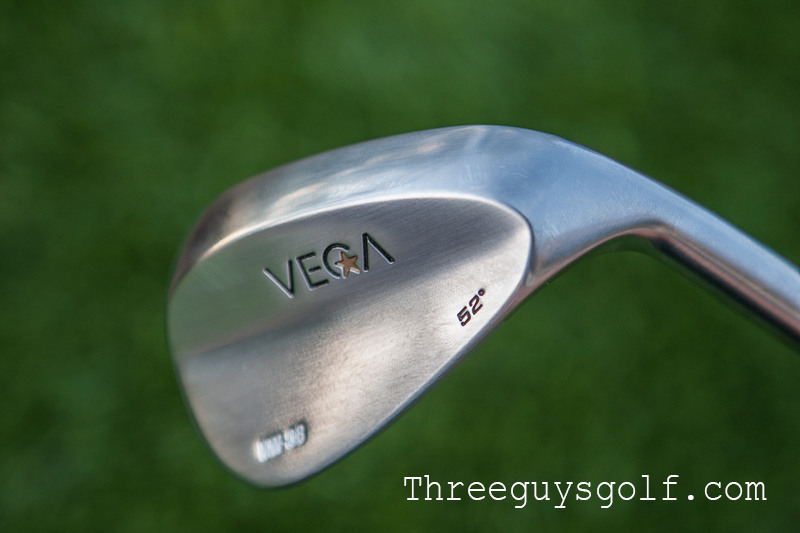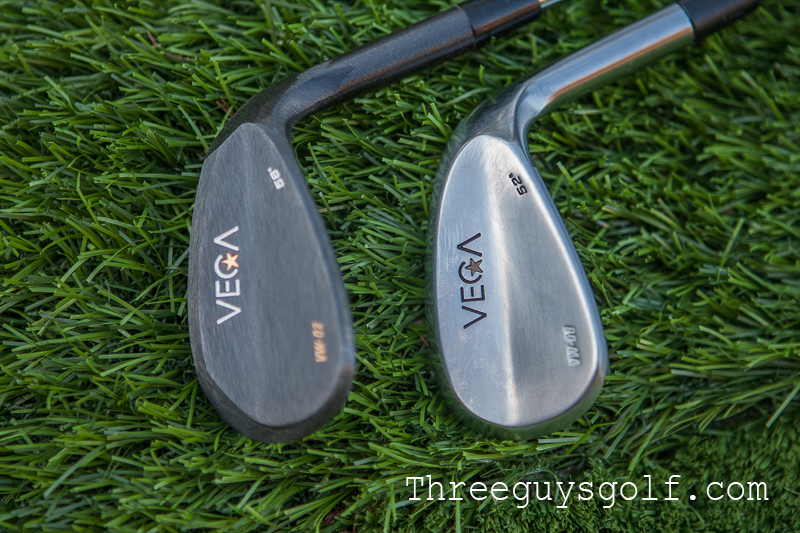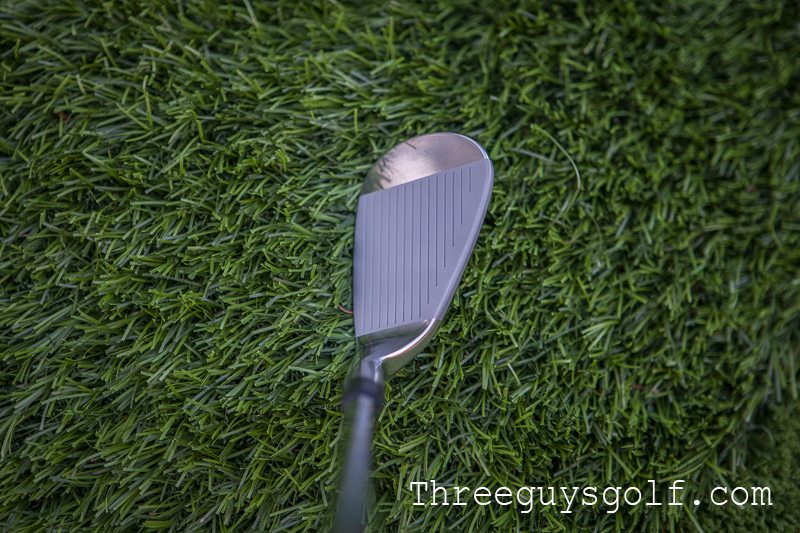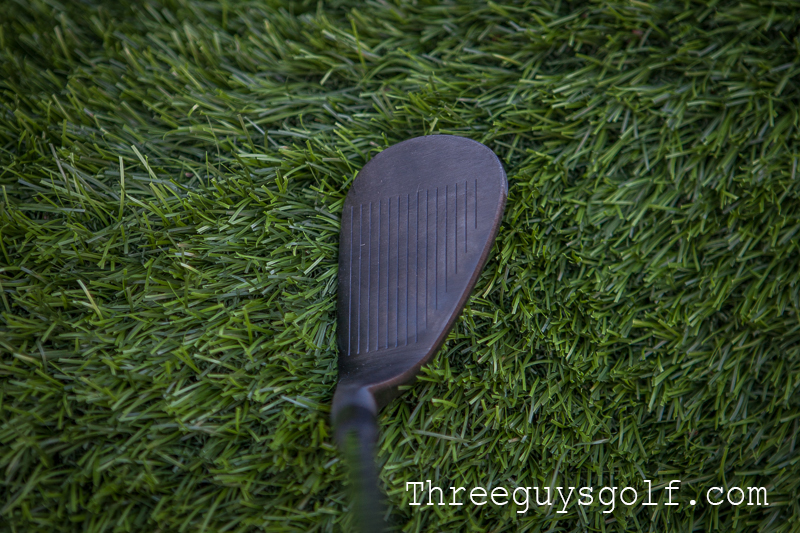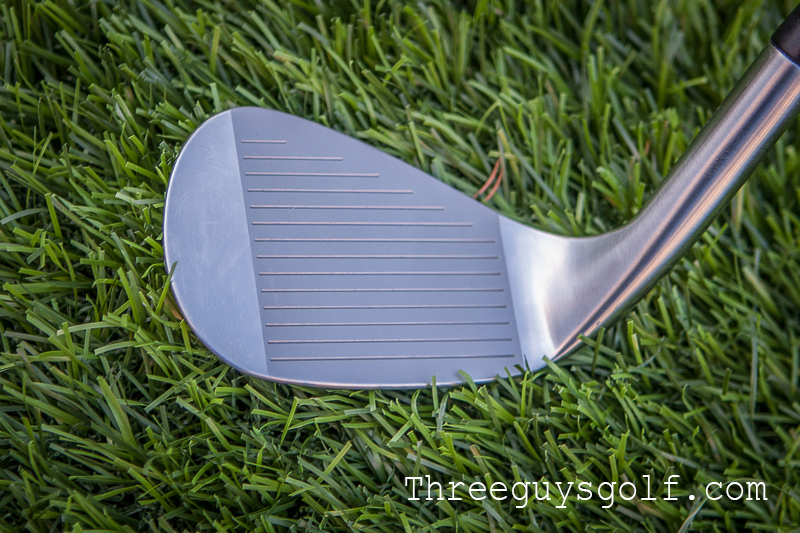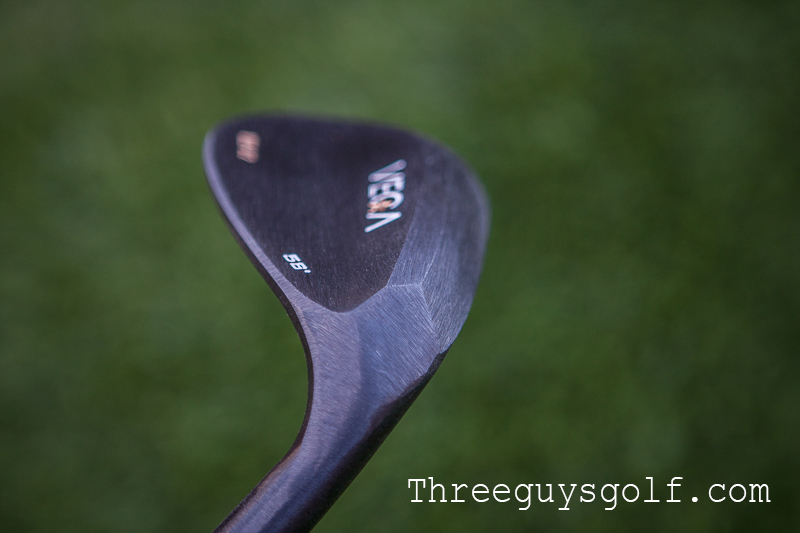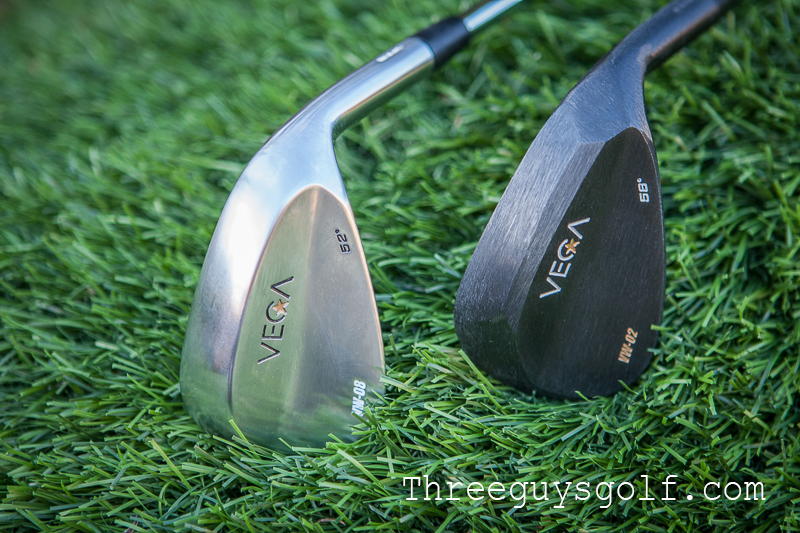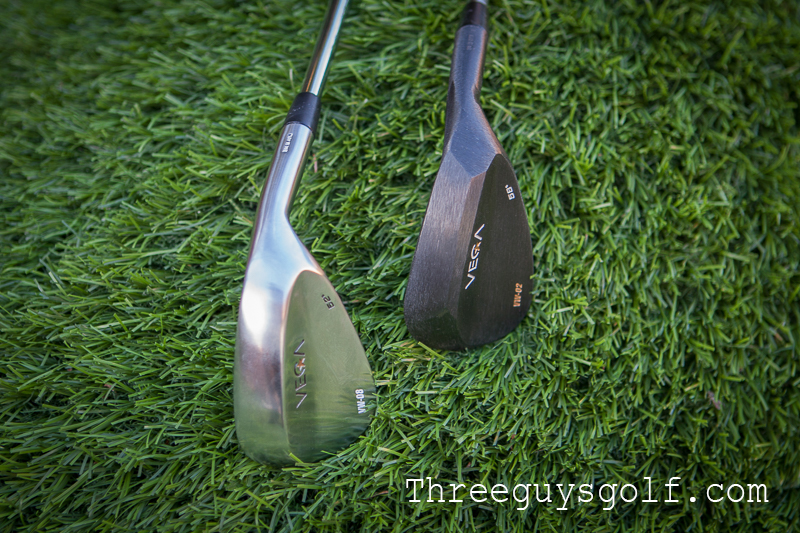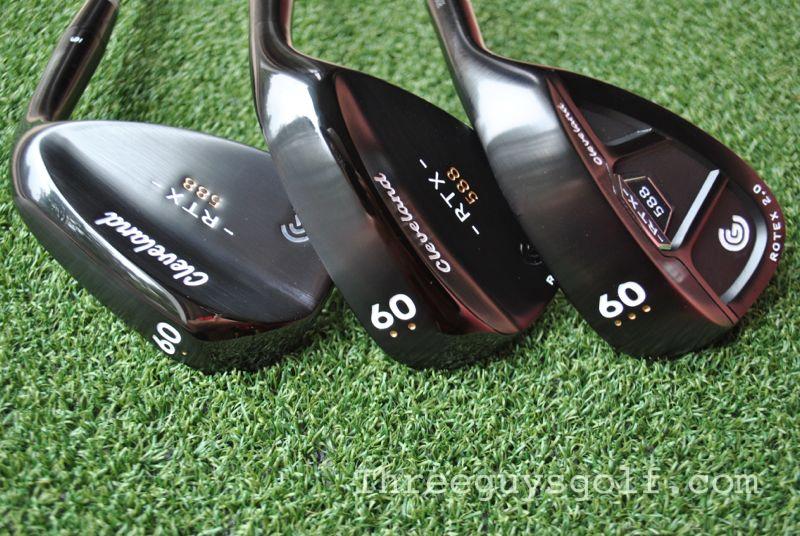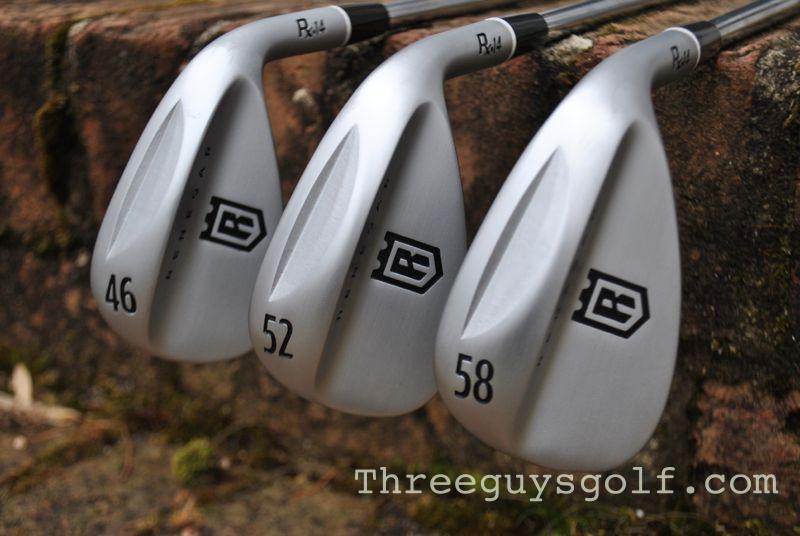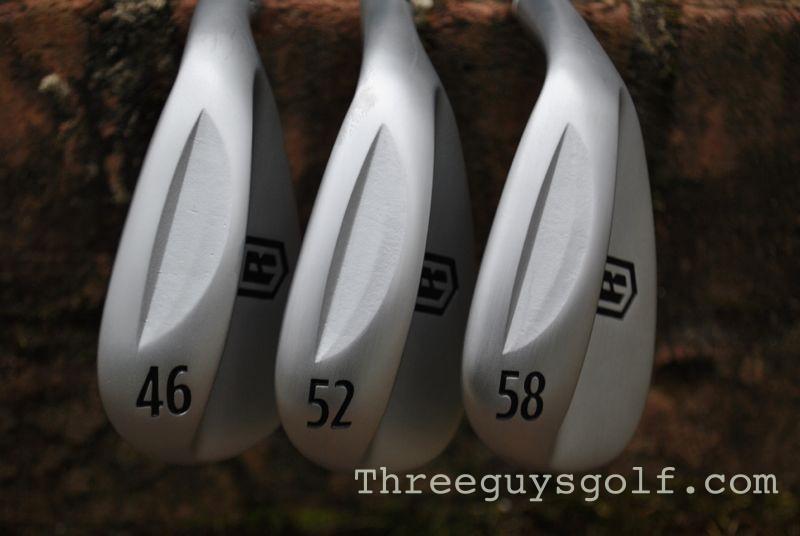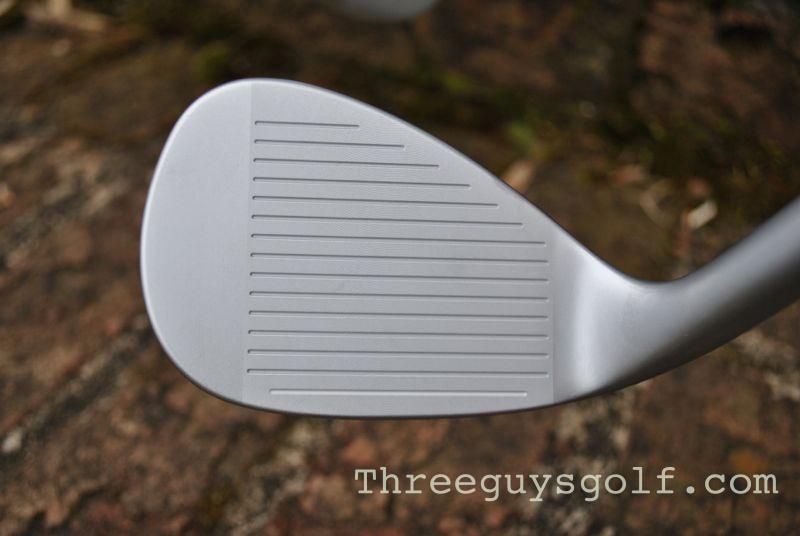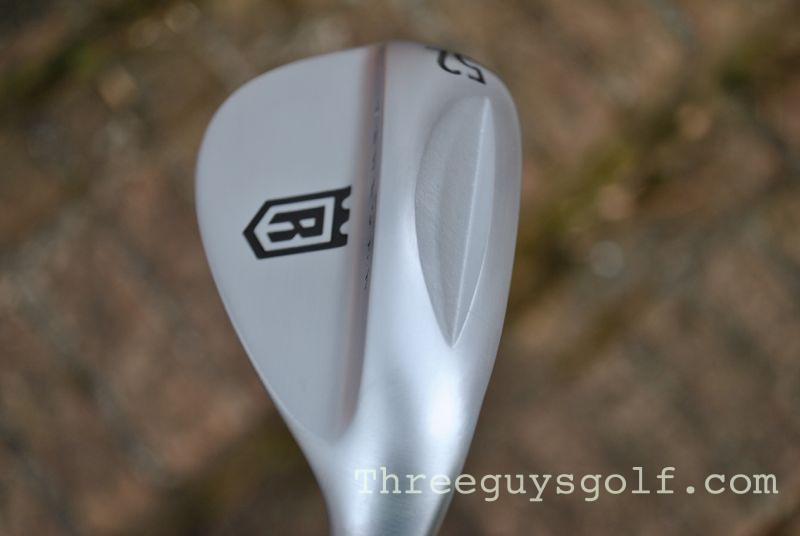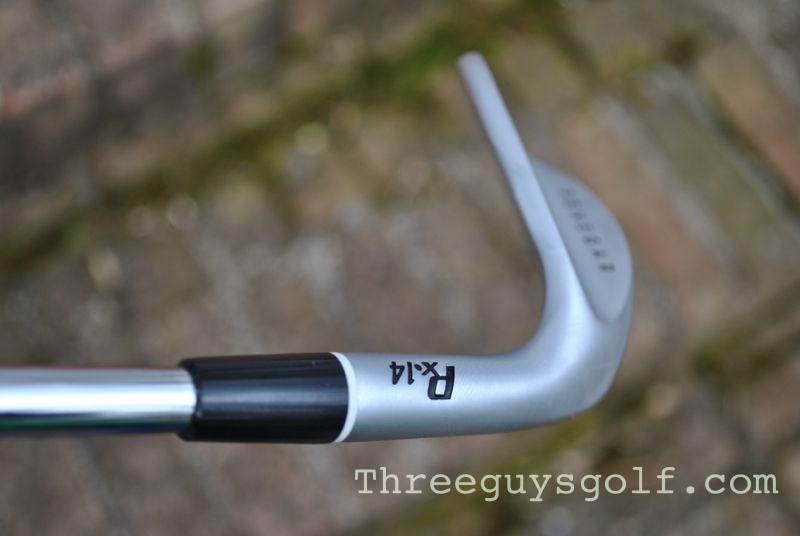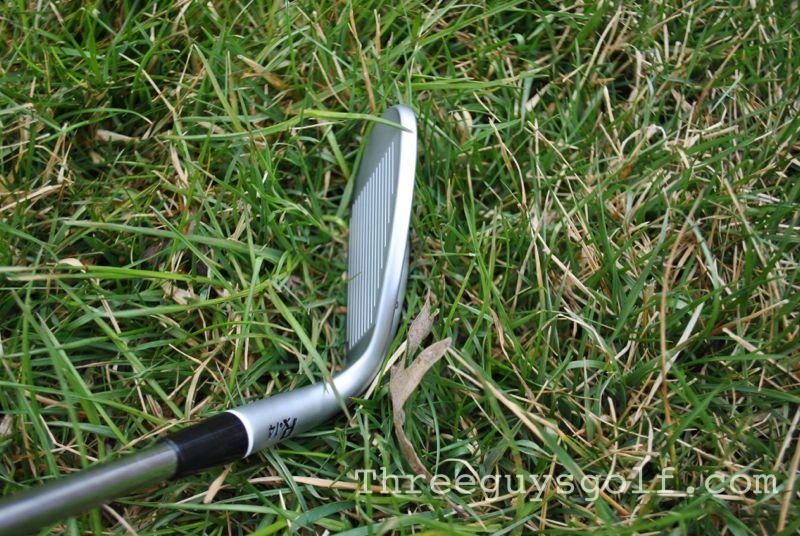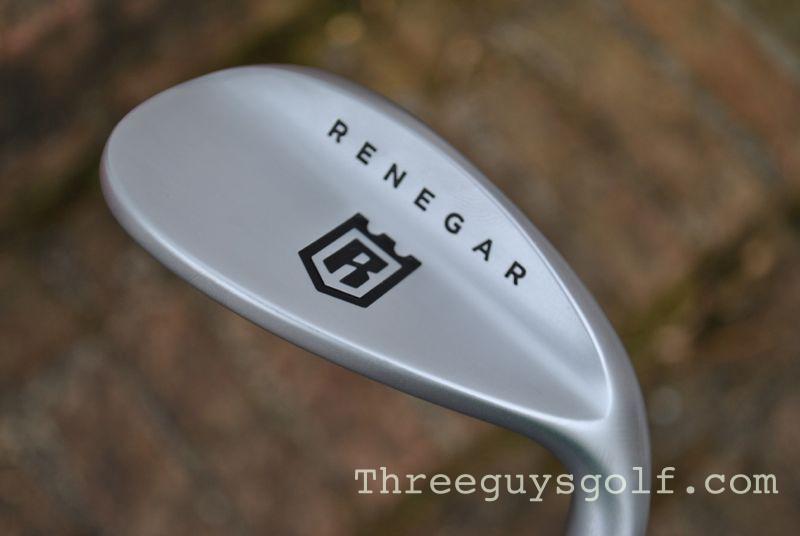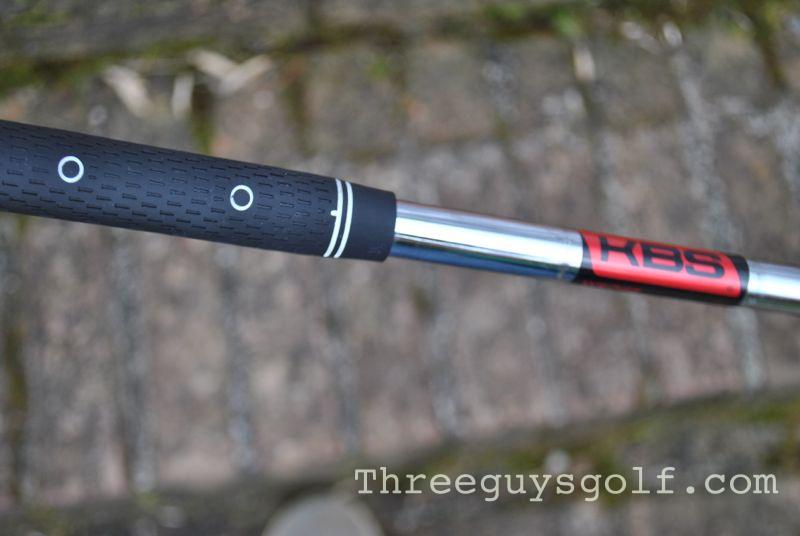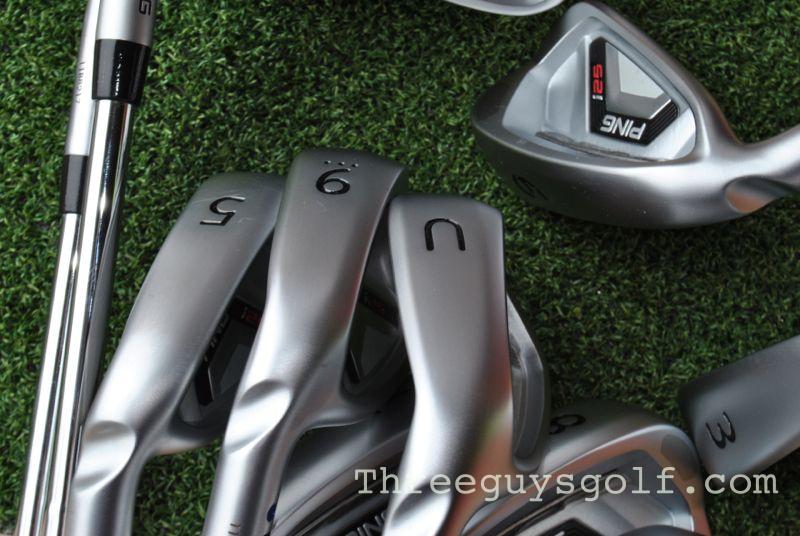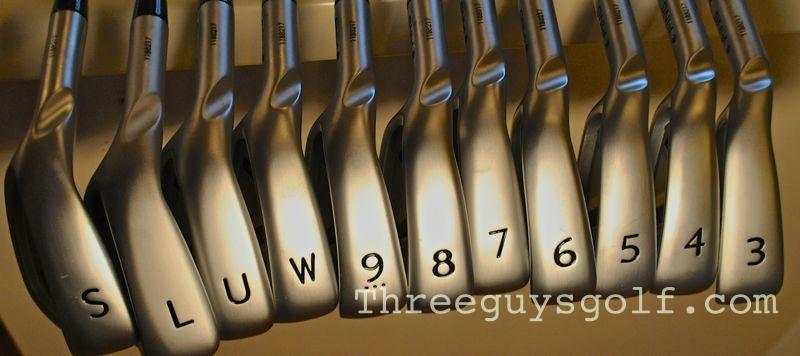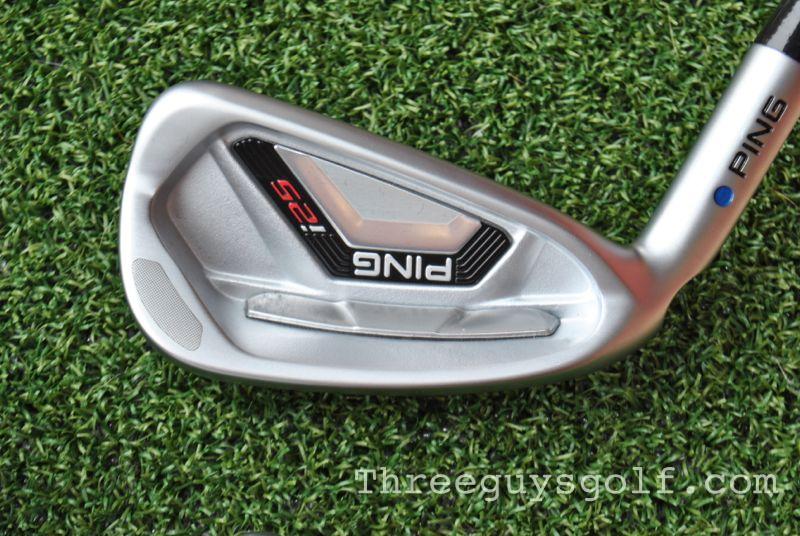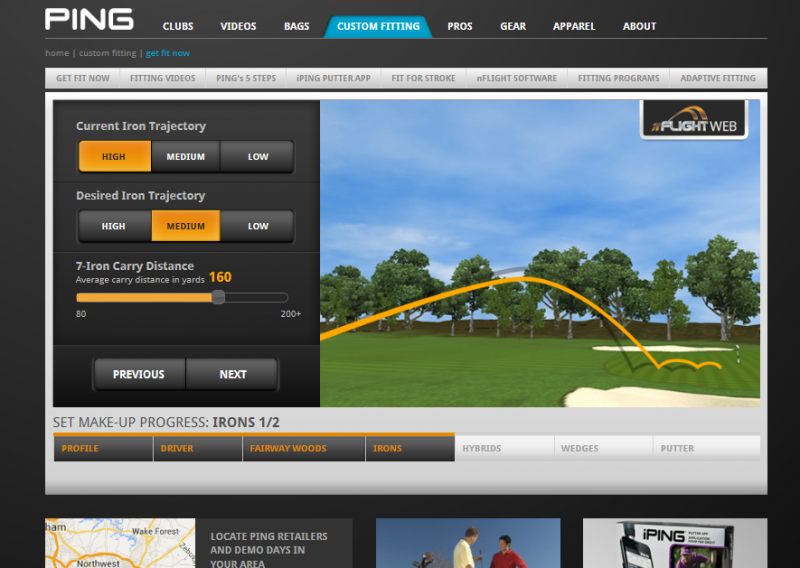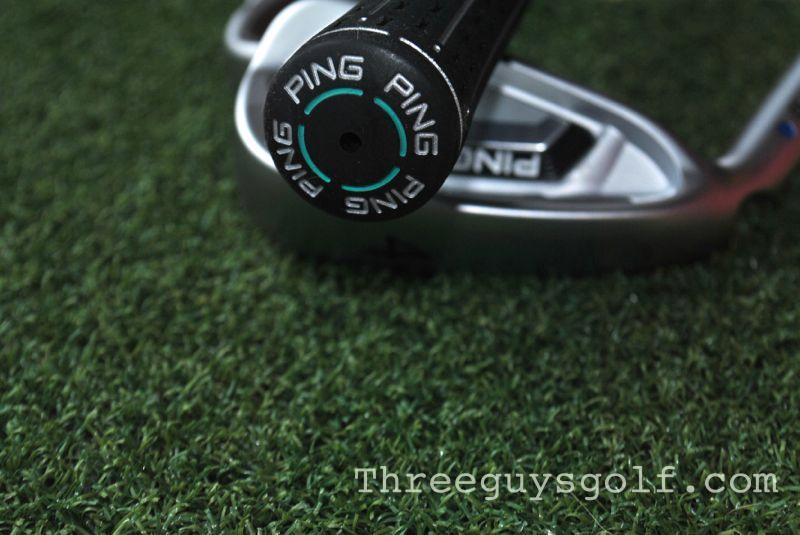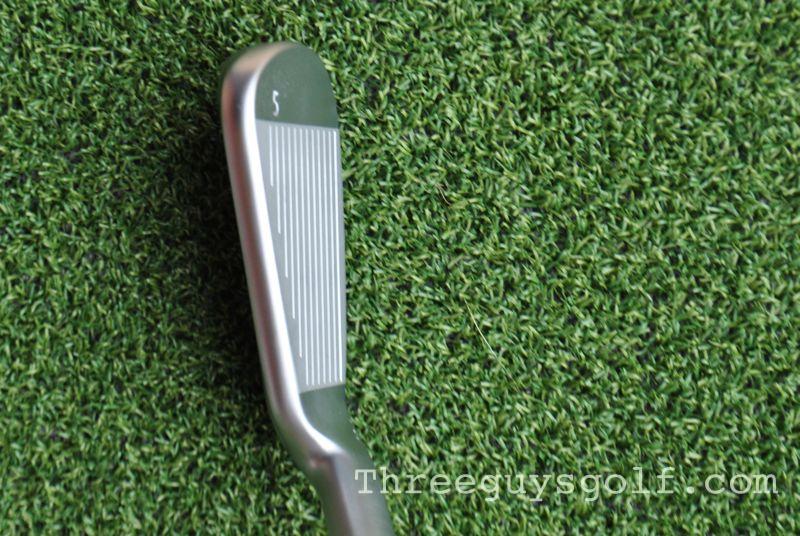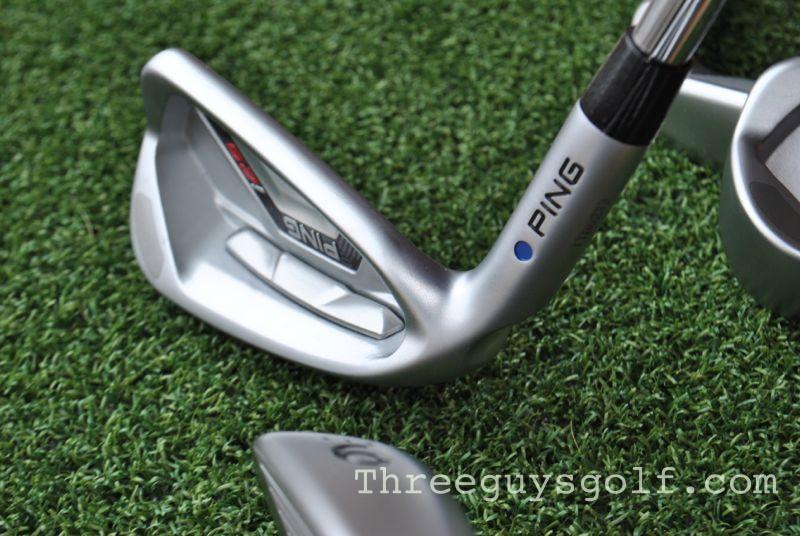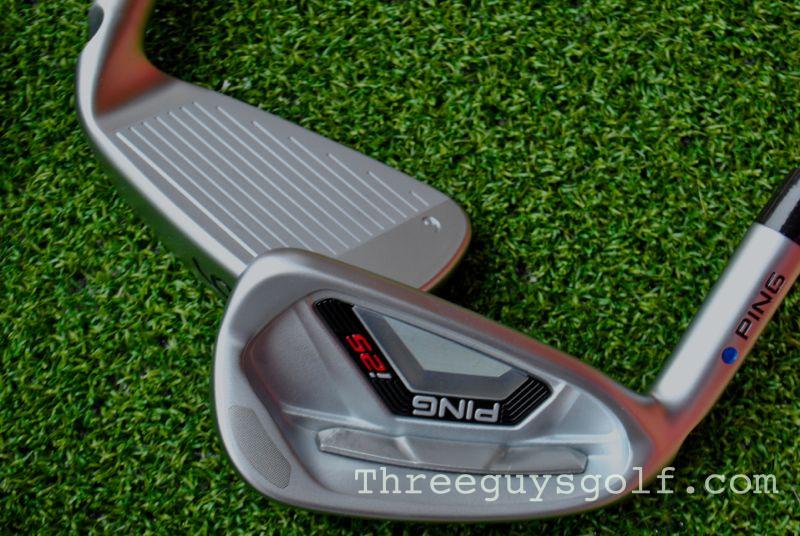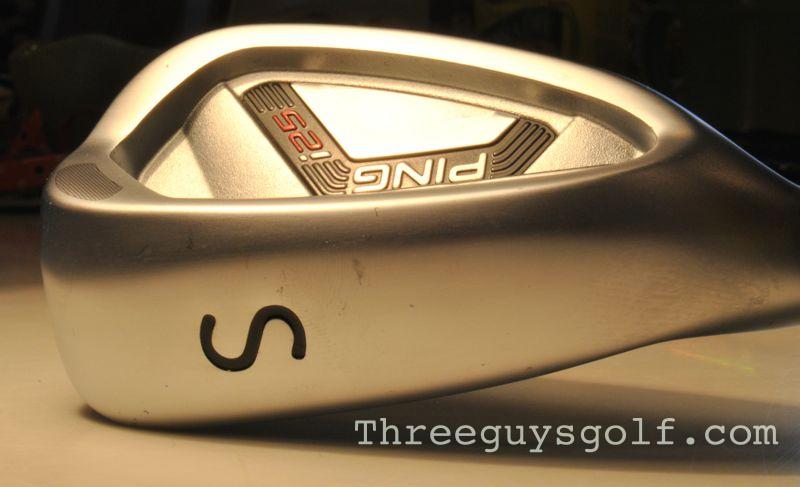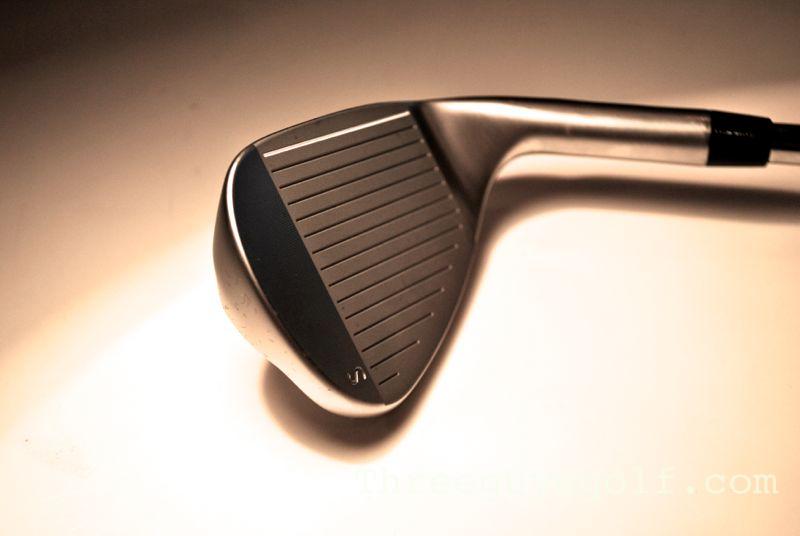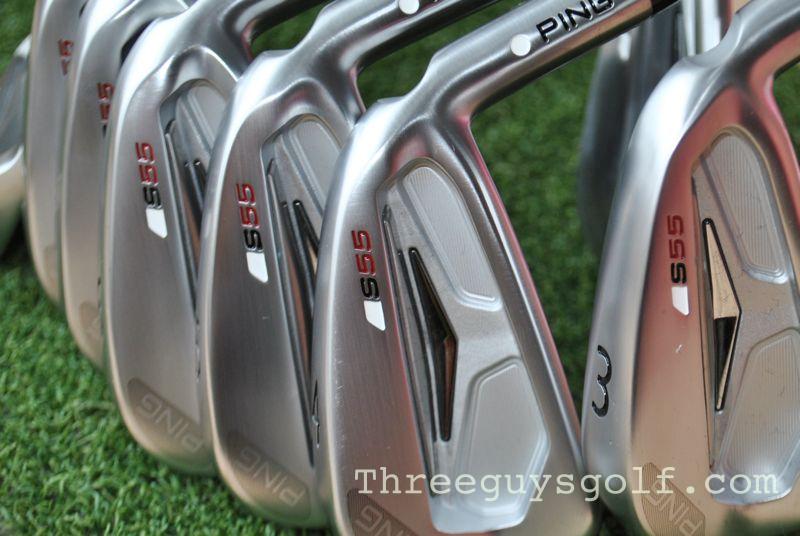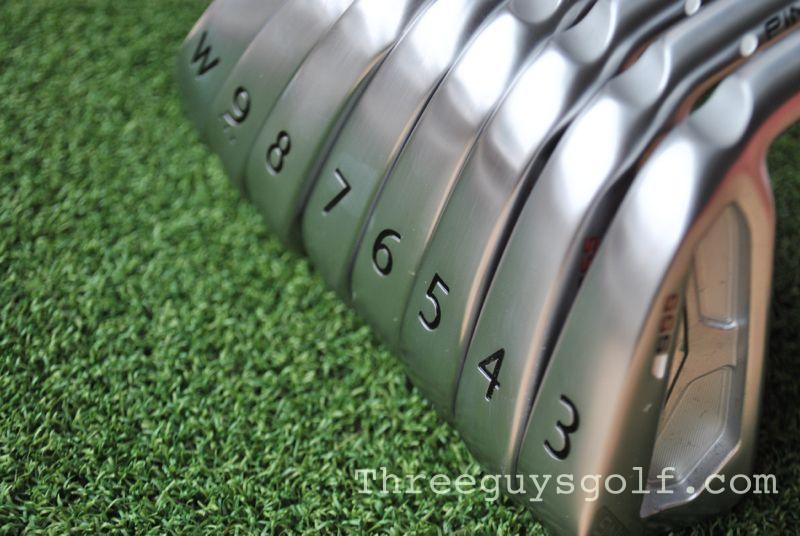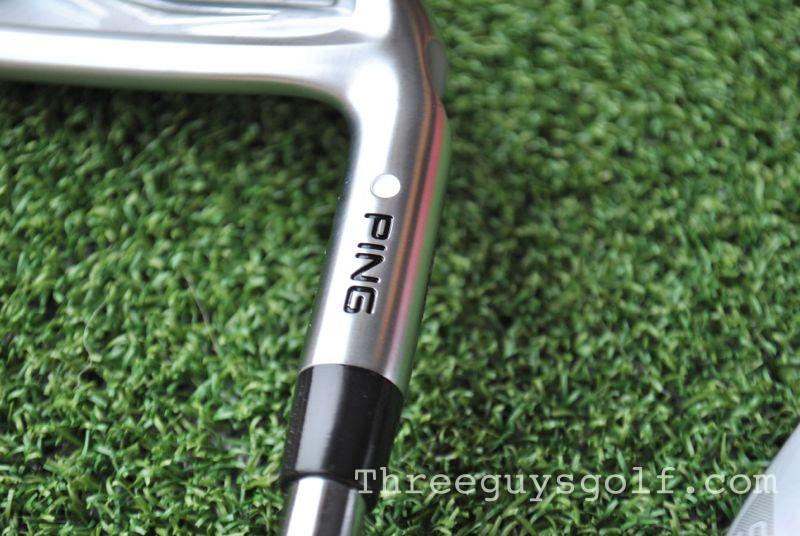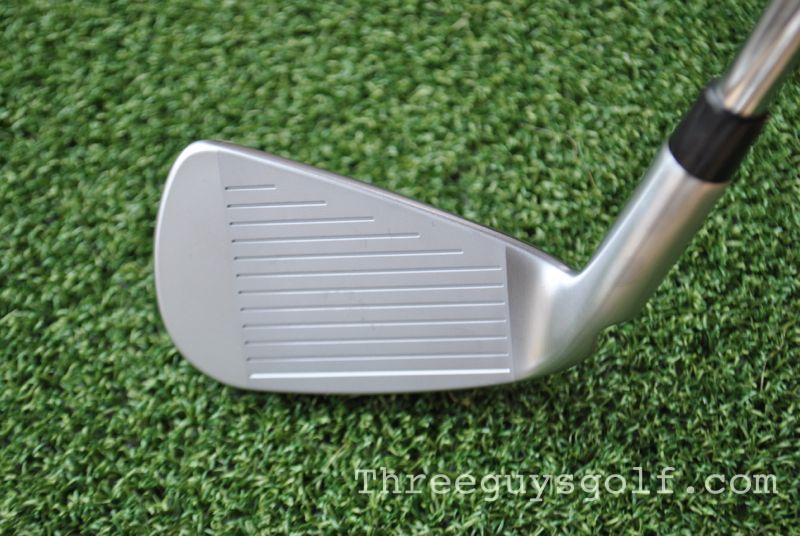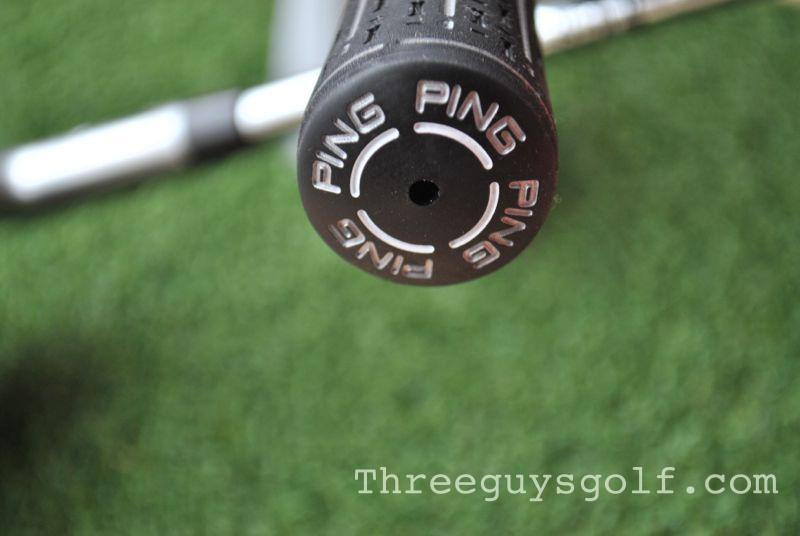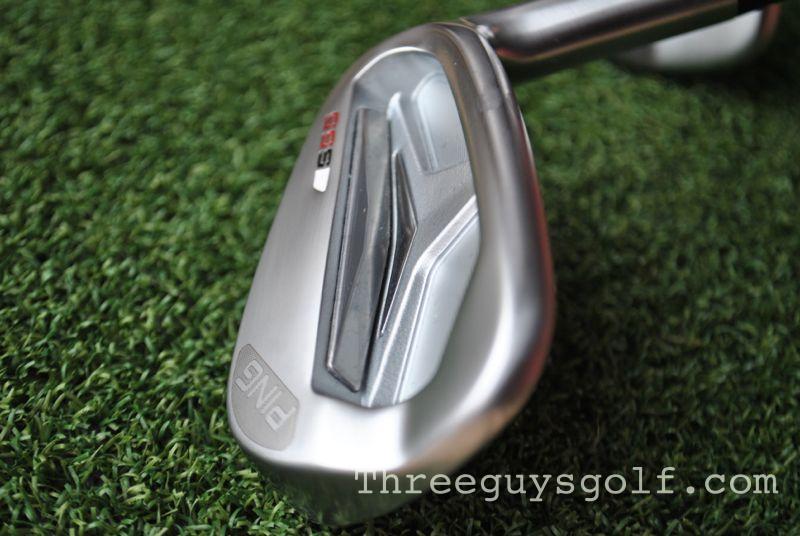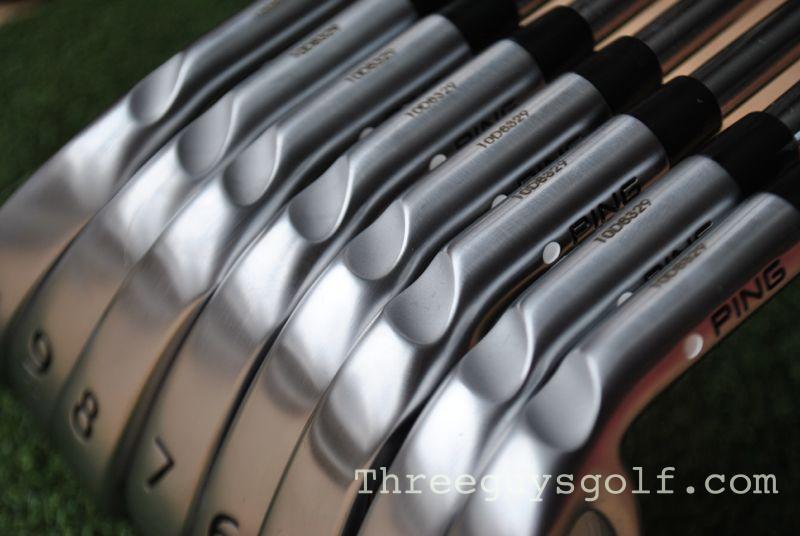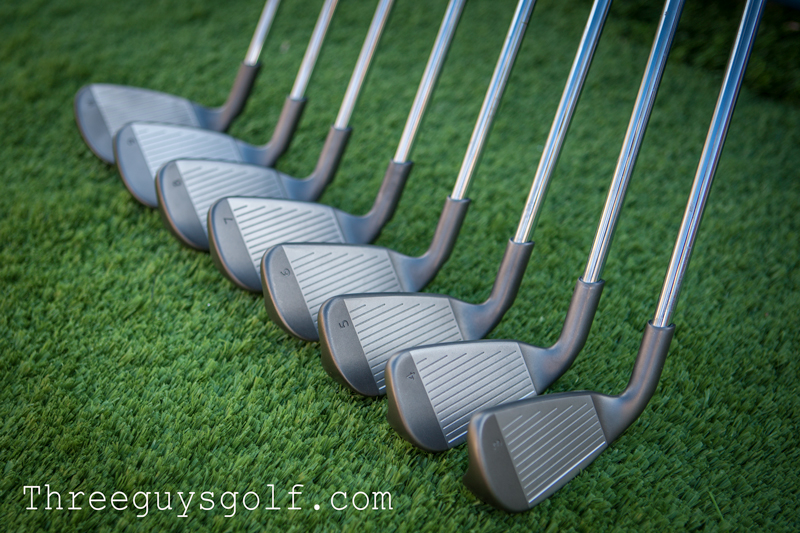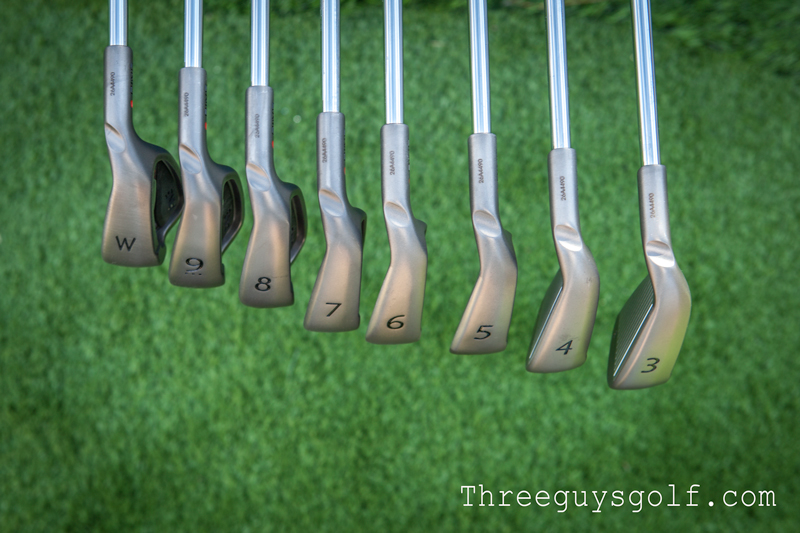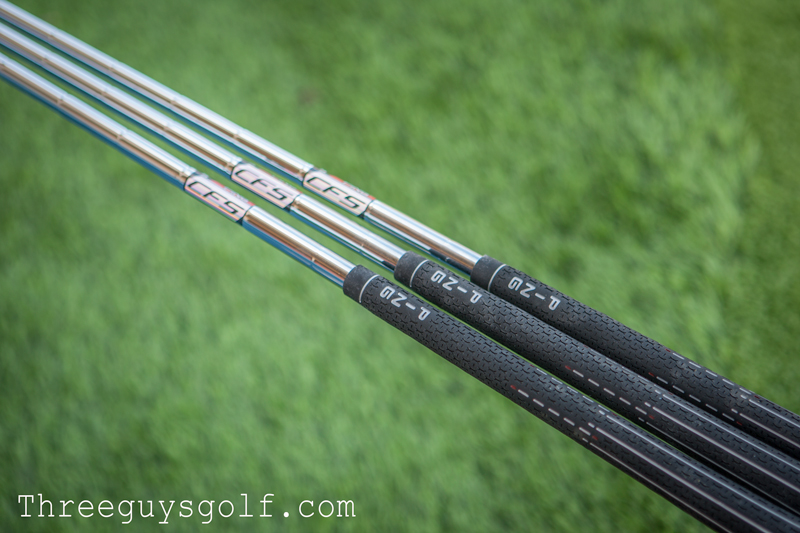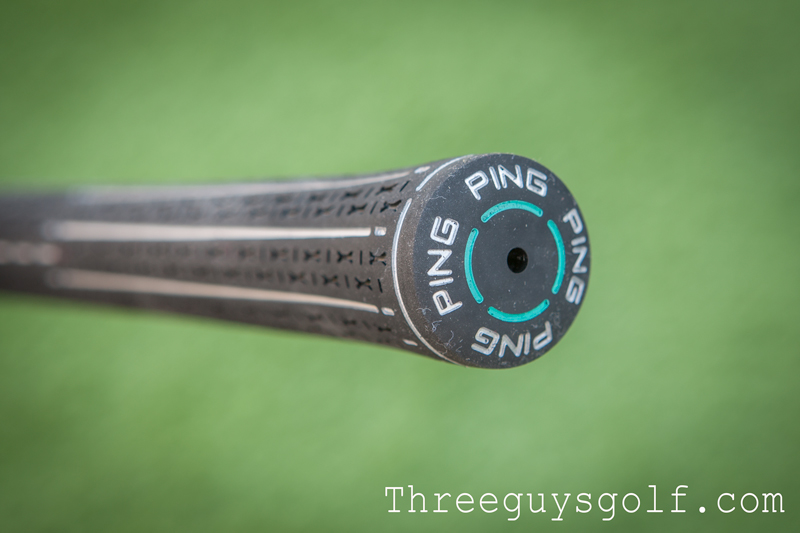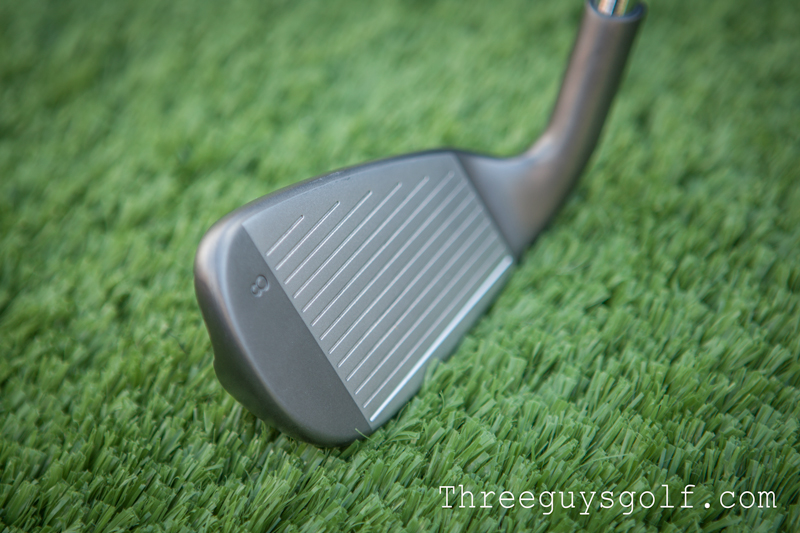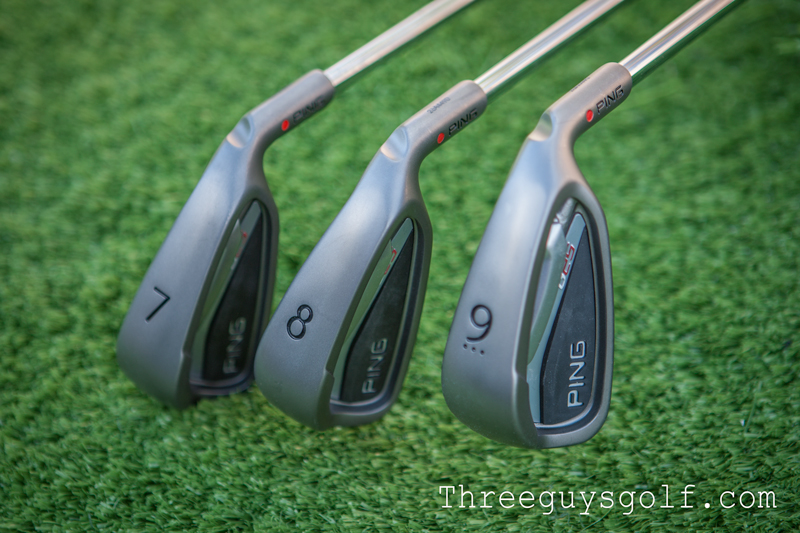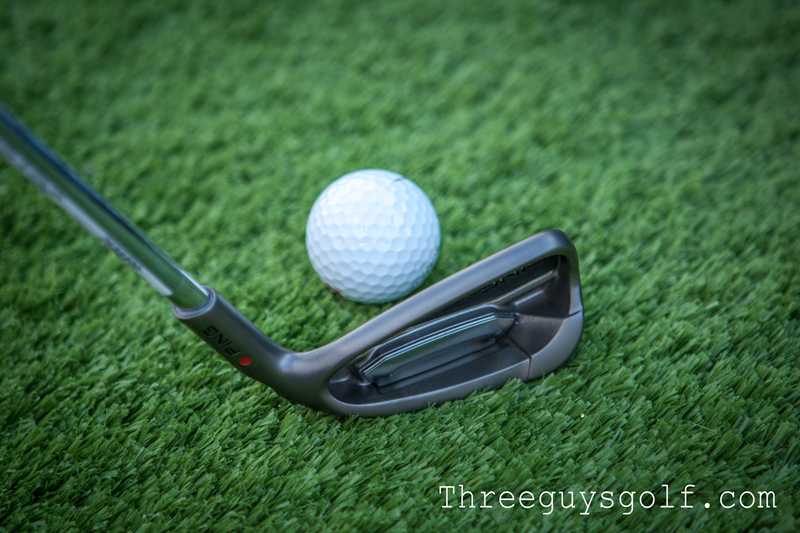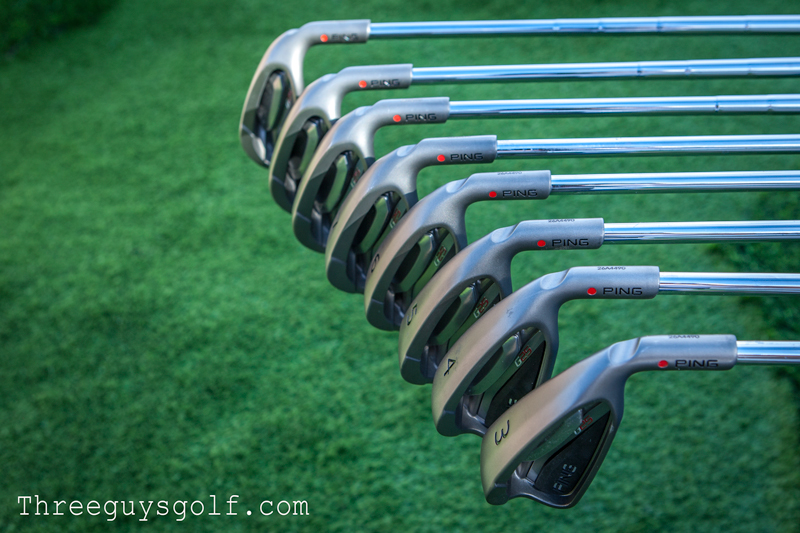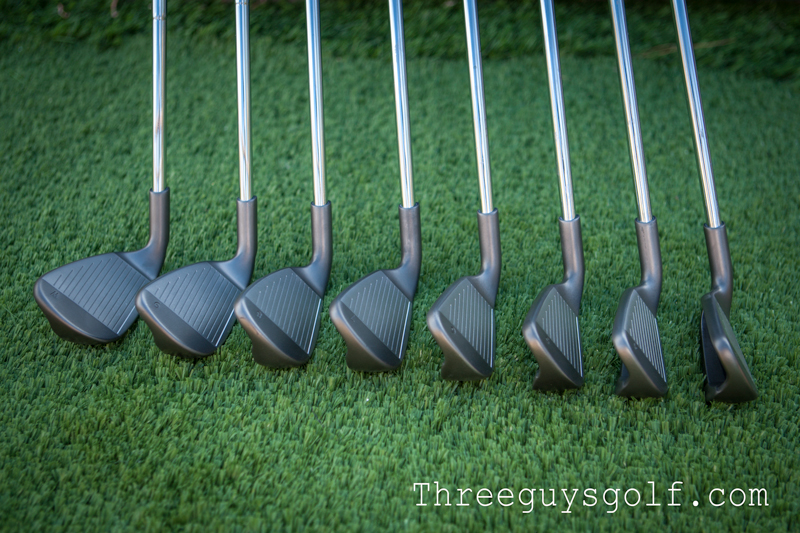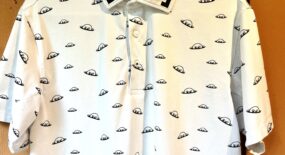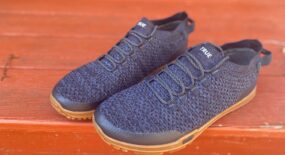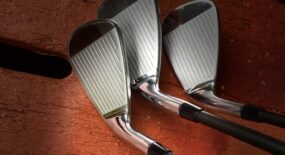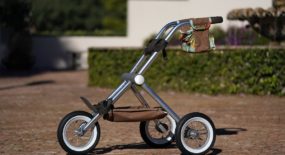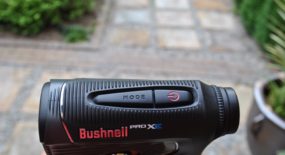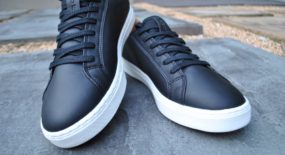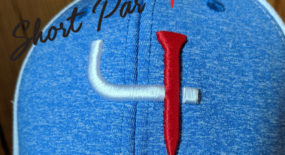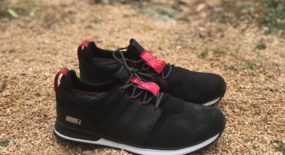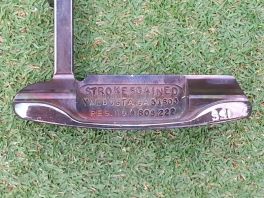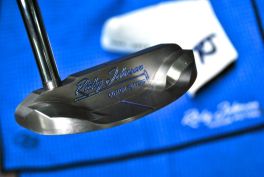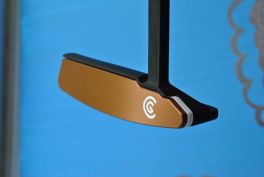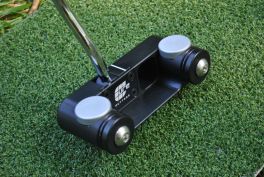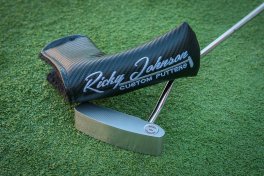Wilson, once a giant in the golf industry has been through a lot over the last 20+ years. When I was growing up in the 80s, Wilson along with MacGregor, and Ben Hogan were the irons to have. In fact my first set of Irons were a set of Wilson 1200 Jrs back in the 80s. What was cool when you were a kid always holds a spot in your heart, particularly when you get older. I have been tempted to go back, particularly with a set of Ci5s back in 2009, but never took the leap. They make really good looking clubs, particularly their blades and player distance irons. While you don’t see a bunch of Wilson’s out in the wild, they have maintained a presence on tour, including major winners Padraig Harrington and Gary Woodland. So needless to say, when I was approached with the opportunity to test out the new D7 Forged Irons, I jumped at the chance.
We have all heard the phrase, “it’s not the club, it’s the golfer”. While there is certainly a lot of merit in this philosophy, there is clearly an argument to be made that a better set of golf clubs can make you a better golfer. I think this is particularly true for the mid handicapper who is not blessed with a repeatable swing. Personally, I have tested a dozen different irons during real course conditions but it was not until I got fitted for my current set of clubs that I came to fully understand how critical it is to get fitted before you purchase a set of irons.
For the past few years I have been playing the TaylorMade RSi2 irons. I really liked the clubs and felt that I was having some of my best seasons playing with them. Then in February 2018 I was convinced to get a real fitting.
Holy shit, that was the biggest game changing 45 minutes in my golf career. If you have never been to a real fitting (not a Golf Galaxy Golf fitting), then you need to drop everything and schedule one. Let me say this again, DO NOT buy clubs without getting fit.
Historically, the best golfers have always been admired not for their technical skill but for their creativity. While we applaud the 350 yard drive, what really gets fans going are shots like Bubba’s massive hook out of the trees to win the Masters, Mickelson’s ability to see shots no one else could imagine or Roy McAvoy’s persistence to never lay up.
At the 2016 Masters, Bryson DeChambeau took the golf world by storm as an amateur via his stellar play and unique set of irons… all the same length. Cobra clearly liked DeChambeau’s style, throwing a huge endorsement deal his way and doubling down by launching their own line of single length clubs – the King F7 ONE Length irons and the KING Forged ONE Length irons.
$99 for Three Bombtech Wedges?
Seriously, when Bombtech offered to send me their new wedges I was more than a bit skeptical. I am no math major but it is hard for me to figure out how you make money on a $33 wedge that has an ounce of quality in it. I am not picking on Bombtech either, I feel the same about a burger, fries and a drink for $1.50. At some point, low pricing becomes a signal of low quality.
The original Star Wars premiered in theaters on May 25, 1977. That’s 39 years ago next month. When it came out, my cousin and I went to see it in the theater. Four times. In a row. We made lightsabers out of the bamboo that grew in front of our grandmother’s house and bashed each other with them until they splintered, then made new ones and did it again. I’m not sure how we managed not to put each other’s eyes out, but nearly 40 years later we do, in fact, need both of the lenses in the reading glasses that we each keep close to hand (although I still say I could totally rock a monocle.)
Have you ever been watching TV, maybe late at night, or maybe in the middle of the day, and seen a commercial for something that was so mind-bendingly stupid that you asked yourself: “Who the hell would buy that?” I hate to break it to you, but a lot of time and money was spent analyzing that very question, and the answer that the TV executives, MBAs, marketing wonks, and social psychologists came up with was: you.
Way back in 2012, I posted my first iron review and it was for a set of irons I actually paid money for (the horror!). Those TaylorMade Burner 2.0’s stayed in my bag for about 2 years before I upgraded to the Rocketbladez. It seemed only natural then for me to review the new TaylorMade RSi2 irons.
Over the years of playing TaylorMade I have come to believe they are the “everyman’s” club. Basically meaning that in a pinch (like a rental set) anyone can play them and not have any real complaints. I guess what I am saying is that TaylorMade irons always have fairly classic lines, decent forgiveness, and enough distance for nearly every level of play.
In the case of the RocketBladez, which was my most recent club, I felt like they had plenty of forgiveness and good distance. So when I got the RSi2 irons I was expecting your basic version upgrade with maybe a little more of both. What I found, however, was a little different than just a rocketBladez v2.0.
Back Story:
Before getting into the nitty gritty, I need to give you a little backstory. In early Novemember 2014, I received the RSi2 irons as part of the company’s November 15th roll out media blitz. The original plan was to have the review ready by that date so that Taylormade could have a bunch of reviews on hand for those interested in upgrading their irons. Unfortunately, the set that I received came with Tour Stiff KBS shafts. Like a trooper, I took them out on the course and while I really liked how they felt, I was giving up a ton of distance due to the fact that I needed regular shafts. Lesson one…shafts matter.
Shafts, perhaps the most important feature of how a club performs and also one of the least understood. My first intention was to just swap out to regular flex KBS shafts, but after talking to a friend who plays professional golf, I took him up on his suggestion to try out Steel Fiber shafts. More on that later. So after a week blown for new shafts and another few days while I ordered some leather Best Grips, I quickly realized there was no way I could do an adequate review in time for the rollout.
As it turns out, the delay was a good thing, as I really do not like to rush an iron review. For me, I need a few months and 20 rounds before I can get a true sense of the club.
Overview:
The TaylorMade RSi2 is more of a player’s club than I originally thought it would be. First off, the top line is thinner than the RocketBladez and the club itself is smaller. What this means is that you will get a lot more feedback than with a club like the Rocketbladez. I also think that it makes it easier to work the ball (not something I can do with regularity, but I can do more so with the RSi2 than with my other clubs).
Of course, the big selling point of the RSi clubs is the face slot technology, which is supposed to provide forgiveness for mis-hits on the toe and heel. Hence the #mishitshappen hashtag TaylorMade has been promoting. For the past few years TaylorMade has utilized this technology in the sole of many of the clubs. Now, they have extended it to be part of the face of the club (with the long irons, hence you get the graduated set).
So the forgiveness/#mishitshappen claim I believe to be true, but it is tempered by the fact that the clubs are more of “player’s club” than say the Rocketbladez. In other words, it kind of evens out depending on what type of club you are coming from. If, for example, you play blades then you will think they are way more forgiving, but if you play a game improvement club, you might not notice as much. For me, I felt like I got about the same forgiveness with more control and feedback. With that said, I can absolutely hit the 3 iron with confidence which is something that is not typical of other irons I have played.
Looks:
No one ever drools over a TaylorMade iron so there is no reason to bring out the chin towel now. How do they look? They look fine. In fact, if you are a iron snob, you will much prefer the significantly thinner top line. The vertical face slots which you might think could be a distraction are a total non-issue for me.
As a comparison, you can clearly see a difference in the top line versus the RocketBladez. While not as thin as a tour blade, they are much slimmer than prior year models.
Steel Fiber Shaft:
In terms of the shaft, the stock version of the RSi2 was only used once by me since this guy cannot swing a tour stiff flex. For the record, the stock shaft is KBS which I have had plenty experience with and is fine. However, as I mentioned, I decided to experiment since I had to make a change anyhow. After consulting with Sam Goulden of TourQuest I decided to go with lesser known company called Aerotech. While you may never have heard of Aerotech, you are very familiar with guys who use their shafts as there are a number of Pros who use them including Matt Kuchar.
I know this is a TaylorMade RSi review, but I want to at least give you an overview of the Steel Fiber shafts as I think they were a critical reason as to why I like the irons so much. As a 10 handicapper with medium swing speeds, I always opted for regular steel stafts (and even wondered about trying a graphite shaft). Well, Steel Fiber shafts are like getting the best of both worlds. The technology is a touch over my head but, basically, they take thousands of ultra thin strands of steel to create a shaft that is light (to promote swing speed) and strong (to promote stability).
Like any product review, there are tons of variables that go into the final result. What I want to convey is that I firmly believe the Steel Fiber shafts have improved my distance and feel. Part of my reasoning is that I hit about 20 balls with both the RSi2 and my RocketBladez in the simulator directly after getting the irons reshafted. My distances were significantly farther with the RSi2 compared to my regular shaft RocketBladez. Yes, I could give the credit to the RSi2 irons (and maybe I do a little) but I think the primary reason was the shaft. Frankly, TaylorMade is not selling the RSi2 as a longer iron so it furthers my belief that the shaft should get most of the credit. I would direct you to the Steel Fiber website to learn more.
Forgiveness and Feel:
I have now played with the RSi2 irons for a full two months (likely about 15 rounds). Considering conditions are not exactly perfect this time of year, I feel like my game has been pretty much the same as it usually is (average score of about 83). With that said, I made a hole in one and shot my career low, 75, with the RSi2 irons. I guess, besides a not so humble brag, the reason I bring this up is that there is something to be said for a set of irons that was used for a career low and an ace.
Back in the world of normalcy, i.e. regular days, I believe the RSi2’s bring an increased level of feedback compared to prior models of Taylormade cavity back irons. For years I had to endure guys who play blades yammer on about feedback and workability. So much so that I even tried a set of blades but all I got back was “yea, that felt awful and went nowhere”. Now, with the RSi2’s, I do get some of that feedback but more in an educated way. Like, “I hit that a bit off the toe”. Unlike a toe shot with a blade however, the RSi2 eats up the mis-hit and you still end up with a decent shot. The ol’ best of both worlds.
Who should play the RSi2
I am going to come clean and say that I don’t believe anyone who is not playing golf for a living should play blades. Still, I know there are guys who like the idea. Well, if you like having feedback from your irons, the RSi2 are for you. Now if you are someone who hits the ball pretty well already and want a little more workability but do not want to give up the forgiveness then the RSi2 are for you as well.
Basically, anyone under a 14 handicap is fully safe to play these clubs. Scratch golfers can do anything they want with the ball and higher handicappers are not going to feel like they are playing with a butter knife. I am not going to deep dive into the face slot technology since I am pretty sure you have read more than your fill about it already, but I absolutely think TaylorMade has made a significant breakthrough.
My bet is that the RSi irons will be a huge hit and should be part of everyone’s basket of ideas when checking out a new set of irons.
Learn more on the TaylorMade website.
What’s in the bag, or WITB for us golf geeks, is a staple of every Monday morning press release. This is where everyone oohs and ahhs at what clubs the winning pro used to win the latest PGA event. Sure, I am interested in what driver and irons were involved in the victory, but it’s the wedges and putters that I primarily focus on because, right or wrong, I can still hold out hope that my short game can become world class with the right tool of the trade (don’t go bursting my bubble).
You see, in my head I’ve always had an idea of what these exotic clubs were all about and imagined that if I could get my hands on them my game would magically improve. Earlier this year, I got my first chance to put this notion to the test when I reviewed the Giannini G6 putter, and while I am still seeking my Tour card, I firmly believe there is absolutely a clear difference between mass-produced and boutique clubs. For one, the simple act of opening the box provokes feelings akin to paging through a Playboy for the first time, those articles… they’re amazing!
The clubs we received from Vega were the VW-02 in the Raw finish with a 56° loft and the VW-08 in the Satin finish with a loft of 52°. I’m gapped at 4° starting at 52° so the wedges fit perfectly into my current setup.
Delivery Day: They say good things come in small packages, but when I saw the box from Vega was no bigger than a loaf of bread, I was perplexed. Were they foldable clubs or a miniature version of the real thing? As it turns out, neither. Vega had sent me just the club heads. ARGG! Rather than heading straight to the range I was now going to have to wait a couple more days since they would need to be shafted.
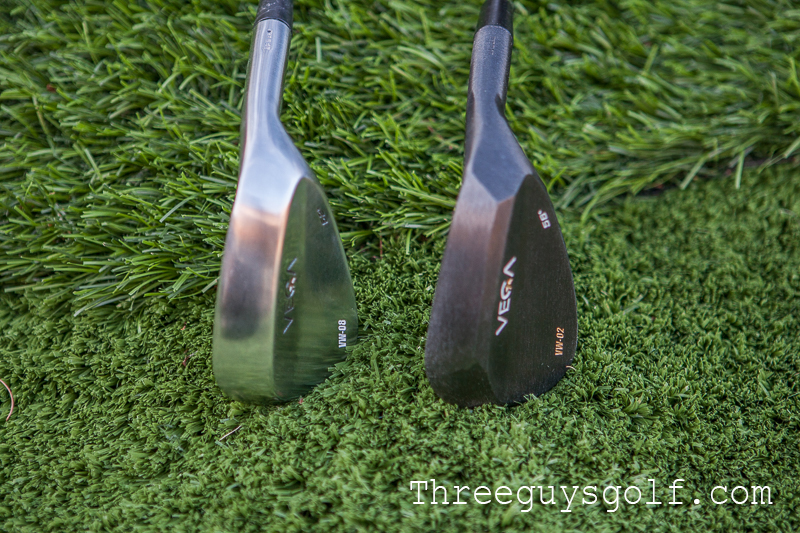
As it turns out the way the Vega’s were shipped was a blessing in disguise. Since I needed to get the shafts and grips installed at my local golf shop I was able to match them to my most recent club fitting. During that fitting a big change was made to my equipment. I went from a stiff, lightweight shaft to a regular flex one that is heavier compared to what I’ve used in the past. Being able to get the Vega wedges setup with the same configuration as my other irons has been a huge benefit – that’s obvious, right?
Since I was going to have to wait a few days before I hit the wedges, I tried to temper my anticipation by doing some further research. What I realized was that Vega offers a proverbial boatload of options.
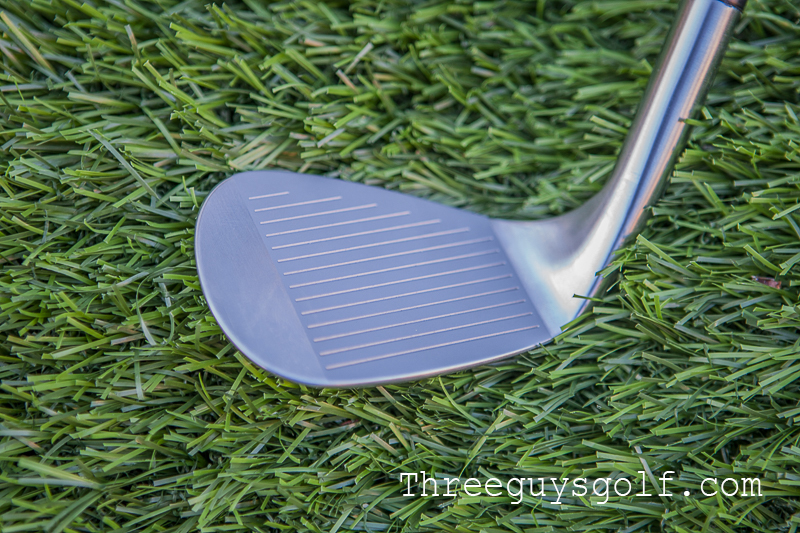
First off, the Vega Wedges come in three different finishes; Satin, Brushed and Raw. The Satin finish is a stunning look for any club but with the elegant design it is outstanding on the Vegas. If you’re not a fan of the clean, smooth look the Satin produces, the Brushed finish is an excellent variation with a more aggressive tone, while the Raw finish is without a doubt the club you don’t take home to mother. The dark appearance just screams “Don’t mess with me!” and is easily my favorite variation. Additionally, the Raw and the Brushed finishes are not plated and will rust over time, similar to the old Cleveland and Callaway wedges.
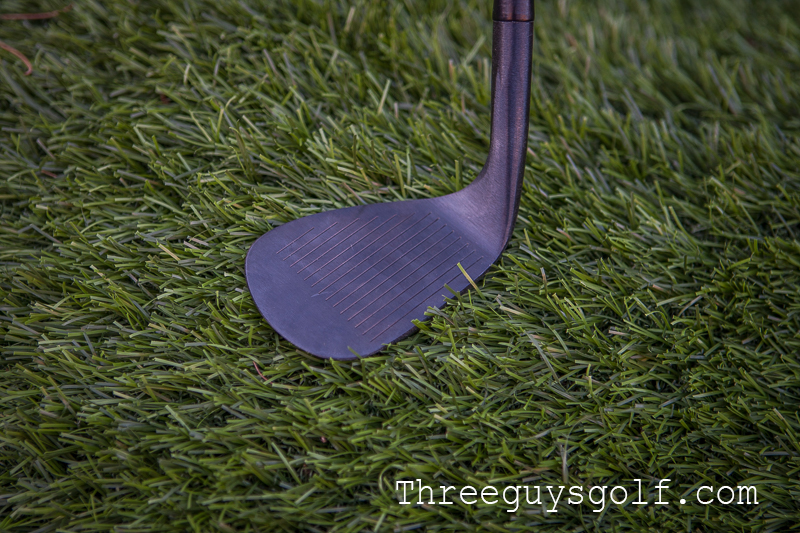
Beyond the three choices in finishes, Vega also offers five different sole grinds so you can get the exact type of grind you are looking for to fit your game. Here’s a breakdown of their unique grinds:
The VW-02 wedge comes with the Angular Tri Grind which features three very distinct grind areas with toe and heel relief. Vega states this is an aggressive wedge to play. For me, this means I feel comfortable using it in even the most difficult lies.
The VW-04 wedge comes with the Three Port Grind which offers cutbacks on the heel and toe areas of the club, enabling this wedge to cut through the rough.
The VW-06 wedge adds a little extra grind to the heel which allows the club to be laid wide open while still maintaining the low bounce.
The VW-08 is your classic wedge in looks but Vega uses a versatile sole grind making it a very playable club from all types of lies. Being more traditional in looks and in feel, this has been my go to wedge around the green and within 90 yards.
Lastly the VW-10 is another traditional looking wedge with one unique element that makes it one of the most resourceful wedges there is. The leading edge of the club is curved and when added to the Vega grind, which is similar to the VW-08, the VW-10 is excellent for tight lies.
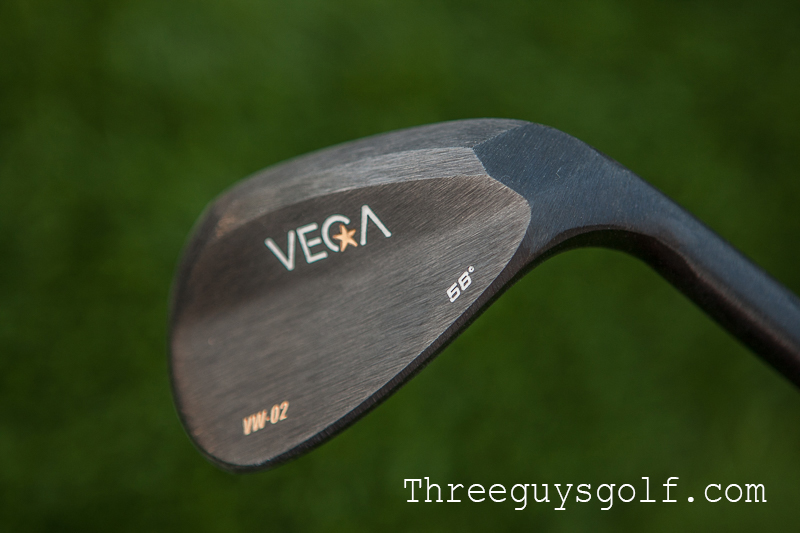
Throw into the mix loft variations of 50°, 52°, 54°, 56°, 58° & 60° and you can see the possibilities are near endless. Five grinds, three finishes and six lofts (on a few clubs there’s also a 48° option) equals 90 different wedges available and I didn’t even mention the clubs offered for lefties. Yes, Vega was nice enough to take care of those folks from the other side of the stance too!
Gorgeous, stunning, splendid, marvelous are all great words to describe the craftsmanship of the Vega wedges. The grinds are so clean they appear more like works of art than tools to attack flags!
Unfortunately in golf, beauty will only get you so far (unlike in real life) and it certainly won’t help you stuff it close to that back right, tucked pin. The clubs have to perform, and from the first time I struck a range ball before my first outing with the Vegas I was sold.
On course testing: When I finally got my mitts on the shafted clubs, I quickly headed to the course to see if the performance could live up to my lofty expectations. So jacked to hit these guys, I didn’t even care about my tee shot, I just wanted to get about 100 yards out so I could put one of the clubs in play on the first hole.
Almost immediately I fell madly in love with the 52° VW-08. For me a 52° wedge is my go to club anywhere from 100 to 75 yards out, but I also use it for chipping and short bump and runs around the green.
The 56° VW-02 I use for short chipshots and as my sand wedge for greenside bunkers, if they’re not too far away of course. With the special Tri Grind there hasn’t been a lie I’ve found where I can’t get the club to lay wide open, which has helped me get out of some tricky spots and also some nasty bunkers.
As a reference point, it may help to know that I’ve had my current set of wedges for over two years and I never imagined I’d find another set of wedges I like well enough to make a change. Well, it looks like my old wedges feel a lot like the broom and dustpan from the Swifter commercials. Sorry old friends, you have been relocated to the “extra club” bag.
As you can imagine, the Vega wedges are a bit more expensive than your average club so it is worth considering whether they are right for you game. While I have been extremely impressed with the clubs, I thought it would be valuable to get some insight from a real Pro who also plays the Vega wedges.
Interview with Sam Goulden:
Bio: Sam is the founder of TourQuest, accomplished player, respected instructor and author of Square to Square. As an active member of team #TourQuest, Sam is traveling all across the country vying for spots in some of the PGA events by playing in the Tour Qualifiers. Everyone, including Sam, knows the importance of solid wedge game and Sam trusts Vega to deliver for him when he needs it most.
I first want to say thanks to Sam for taking some time out of his busy schedule to answer a few questions about the Vega wedges for us and, by doing so, adding some valuable insight to this review.
TGG: How long have you been playing with the Vega wedges?
SG: I was fitted in early May and have been using them since then.
TGG: Which Vega wedges are you currently playing?
SG: I play the VW-06 in 50°, 55°, and 60°. All satin finish and no paint fill.
TGG: Was there anything specific about the Vega wedges that helped you make the switch? Did the different grinds Vega offers have anything to do with it?
SG: The main reason I switched was for the look and feel. The Performance turned out to be way more than I expected. It was hard to get used to at first. I hit each wedge around 6 yards longer than my previous set with the same lofts. I think the main reason for this is that I got a really good bounce fit for my swing.
TGG: Do you feel the Vega wedges are made only for the high caliber players like yourself or can the mid to high handicapper benefit from the technology used in them?
SG: I’ve suggested Vega for a ton of players. Because of the variability in grinds, lofts and finishes there is definitely a wedge out there for every type of player.
TGG: Since adding the Vega wedges to your bag have you seen any notable improvements to your wedge game? Anything you’d care to discuss?
SG: The main difference in my wedge game has been the feel of the hit and the distance increase. The hit feels really solid. Not soft, not hard. Like hitting a tiny nail with a heavy mallet hammer. They are not heavier than other wedges; they just deliver a really solid blow.
TGG: Thanks for your time and good luck to you and the TourQuest team.
Sam also wanted to point out that beyond making amazing wedges Vega has been outstanding as a sponsor for team #TourQuest. He feels they are super committed to making sure the correct wedges are in their players’ hands and Vega is continually checking to make sure all the guys are happy with everything and offering to help any way they can.
You can check out all of the Vega wedges and options on the Vega website.
Long ago when hair was large and men wore spandex (that would be the 80s, for you youngsters), Ping founder Karsten Solheim applied his engineering background to club design and quickly realized that square-cut grooves could put more spin on the ball while still abiding by the USGA rules. Depending on who you ask this was either the greatest thing since sliced bread or an unmitigated disaster. The USGA was in the latter camp and they promptly banned the square grooves, effective in 2010 (for those not following the anchored putter kerfuffle, “promptly” has a slightly different meaning when applied to the USGA). This led to 2010 being declared “the year of the wedge”, competitors everywhere had to replace their non-conforming wedges. All was not lost, however, as manufacturers milled, spun, and laser-cut the faces of their wedges to try to return the spin of the old square grooves.
After hundreds of product reviews written, I still find that the most difficult ones to to write are for wedges. Why? Well, first because my short game is sometimes a bit suspect. Secondly, I believe people who chip well can chip with a shovel and still get up and down. And finally, wedges have started to come with a whole list of technology like bounce and grind that frankly go over the head for most golfers.
So, with that huge disclaimer, let’s dive into the Renegar wedge review. First off, Renegar is not part of a large golf company. Instead it was founded by one guy named Bob Renegar. Late to the game of golf, Bob started Renegar in 1993. Through the years, the company has gone through a number of design iterations and in the process filed a couple of patents which they believe to be crucial in differentiating their clubs from the pack. Foremost of the design features is the lowered leading edge. This is the part of the club which is closest to the ground at impact. Now for bunker shots, a higher leading edge is fine because the club passes under the ball, but when you are chipping from the ground, a high leading edge can result in the dreaded skulled ball. By lowering the leading edge, the Renegar wedge essentially gives you a touch more forgiveness to reduce the chance of a mis-hit. Hence, the club is just as effective on tight lies as in fluffy bunkers.
The compliment to the leading edge is the bounce. Bounce is what determines how much resistance the club has with the ground or sand. The more bounce the less resistance. Again, in a bunker you typically want a lot of bounce so the club moves through the sand easily. However, when you are playing in varied conditions, hard pan or soft turf, the bounce can have a large effect on how the club reacts to the ground. This is why some players will choose wedges with more or less bounce depending on the conditions.
Where the Renegar wedge design is unique is in the sole because it gives you a number of bounce options based on how you lay the club. This variable bounce feature is created by the UTILITY-patented Sole (the cut-out). At this point my mental capacity becomes a little strained but in layman’s terms you get three bounce ratios in each club. So enough of the techno speak. The Renegar wedges have a few things out of the box that I really liked. First they don’t look like a butter knife that you have to hit perfectly in order to get the ball moving in the right direction. Many of the wedges I have played are so clearly a “pro-club” that they can be a touch intimidating. You know the kind – amazing to look at, nightmare to hit, yea, I got your number buddy.
Because of my inherent “issues with chipping”, for years I chipped primary with my stock PW simply because I was comfortable with the club since it looked like all of my other clubs. I guess my thought was “why hit a club that looks different?” Now clearly I was giving up some control and workability but I was willing to trade that for confidence. As my game improved, I became more comfortable with a more standard 52 or 56 degree wedge but even today I can get a little yippy around the green.
The good news for me is that the Renegar wedge seems more substantial than many other wedges and while I have not weighed it, I would bet it is heavier (at least the clubhead). So for me, the Renegar just feels very natural and comfortable in my hands. Even the muted polish is reminiscent of my irons. Sure, a blinged out wedge looks awesome, but standing over a tricky chip I don’t want to be reminded I am wielding a “specialty club”. In terms of performance, I feel like I get nice spin with all of the wedges. This is in part due to the fact that Renegar mills the grooves right to the USGA boundaries. Again, my short game is not world class but I have really enjoyed using the gap wedge inside of 100 yards. Typically, the 60-80 yard shots are those that require 1/2 or 1/3 swings, but I have found using the 52 degree to be a great option as I can take more of a full swing and get the ball up where in can land softly.
Around the green, the Renegar wedges are fairly easy to use. I definitely think they are more forgiving than some of the more bladier wedges out there. That is not to say you can’t get good touch with them. As a double check, I had two buddies who have great short games chip with the Renegar clubs for 10 or so minutes just so I could get some feedback from low handicappers (one being our club champion). Both men agreed that the Renegar seemed more forgiving and easy to hit. My only real knock is the sound which is more muted than some wedges. I don’t get the true “ting” when I hit a shot super pure. It’s not making a gross thud sound but you’re not gonna get a pure ring of “that was perfect” either. This opinion was also shared by my buddies.
As I mentioned, I really like the fact that the Renegar tries to not look significantly different than my irons. The fact that they are a dullish finish helps to also make them blend in with the pack. Still, upon closer inspection, the “R” logo” on the back is fairly bad-ass for those who like a little bling on the wedge. Well, bling is probably not the right word. The vibe I get is almost midieval since the “R” is outlined with some Knight like castle.
The final piece of the wedge puzzle is the shaft and grip. Now I am not going to even pretend to understand how the shaft factors into the performance of the wedge but clearly Renegar thinks it is super important. The stock KBS shaft are used precisely to compliment the short game. What I do understand are the two markings on the grip which are very useful in adjusting for distance control chocking up to the lower dot should take off about 5 yards from the distance so you can theoretically dial in your shots even more.
Despite the fact that Renegar has been making clubs for 20 years and can boast wins on the PGA Tour, the name remains far under most people’s radar. With that said, I love the fact that they do one thing…wedges. I have always believed in specializing and when a company can set its focus on just making the best wedges without being distracted by drivers, putters, or even apparel, you know you are getting their full attention.
Renegar offers 8 different lofts between 46 and 60 degrees. All clubs can be purchased directly from the Renegar website.
It’s Ping-apalooza here at Three Guys, with Mathew reviewing the Ping G25 irons and Wade reviewing the Ping S55 irons, and I’ve spent the last few with the i25’s. With that I give you the Ping i25 irons review.
First, let me give you the technical scoop. The Ping i25s are intended for players that reside in that gap between the game-improvement G series and the low handicapper/professional S series irons. The predecessor, the i20 iron, was a successful product for Ping and the i25 is an evolution of the same bloodline. The i25s are designed as a progressive set, with forgiveness and high-launch characteristics in the long irons giving way to softer, feel-oriented short irons. The intended demographic appears to be mid-handicapper with a good stroke all the way up to tour players (Kirk Triplett is the only Tour Pro I could confirm to have them in the bag, but hey, that’s enough).
Ping accomplishes this progressive concept by utilizing wider soles, longer blade lengths, and more offset on the long irons (leaning more towards game-improvement characteristics), while the short irons have a smaller blade, less offset, and a narrower sole. I’m boring you to death, but Ping has also utilized weighting to achieve it’s desired center of gravity by way of the “Custom Tuning Port”, which allows them to manipulate the center of gravity on each iron.
My first step in getting my mitts on the Ping i25 irons was completing the nFlight Web Fitting process that Ping offers through their website. Ping considers themselves to be the leader in custom-fitting, and my childhood memories of them being the only folks with color codes and various graphs hanging on golf store walls makes me inclined to believe them. That said, I was actually a bit surprised that Ping would endorse online clubfitting, as obviously nothing beats actually taking some swipes and having a proper session, but I guess this is the age we live in. Anyway, the nFlight program starts with easy enough questions, learning your handicap, height, distance from wrist to floor, hand length, and length of your longest finger. That last one may sound a bit too personal, but Ping actually provided me with a “duh” moment when I realized they were interested in customizing my grip size, which makes total sense. For folks with hands like carnies, perhaps a smaller grip would be helpful, right? nFLight then walks you through your current clubs, how far you hit them now and with what trajectory, then what your desired trajectory would be. All in all, there is enough data going in that you have reasonable confidence that Ping is hooking you up with the right set of sticks.
One thing to note, however, is that I initially misread the question of how long my driver goes, thinking they meant carry, and I was prescribed a set of Karsten hybrid/iron combos with a regular flex shaft, which would have been a huge disappointment had they turned up at my door (they are super game-improvement clubs, not what I’m looking for). Luckily, I knew enough about requiring a stiff flex that I went back and did the process over, feeling better about the results the second time. So like anything, go in with your eyes open because the slightest tweak of certain variables will drastically alter the recommended clubs and shafts. Wade actually mentioned the same thing in his S55 post, so . . . you’ve been warned.
Anyway, doctor’s orders were for the Ping i25s with stiff steel shafts (Ping CFS), a blue color code for lie angle (0.75 upright), and a grip code of aqua. Bring it!
Real quick about me and Pings. Since day 1 I was keenly aware that Ping was making top-caliber sticks because, I swear, for the first 5 years I played golf almost every good golfer I got paired up with was wielding a set of Ping Eye 2s. I’m talking almost EVERY time I played with a legit baller, he had the Eye 2s. Being a lefty, I never got a chance to try them out until they were long discontinued and I was foraging 2irons out of a Play It Again Sports barrel (hint, it’s not the same). But because I had Ping on the brain, every time I got fitted for a new set I would be sure to give the Pings a whirl, and every time I would come away just thinking that the Ping feel was too “soft” for me. Pings struck me kind of like Saabs – their owners are fiercely loyal and way into something that might not be my cup of tea, but their decision is to be respected. As it went, I would always get hooked on a set of irons that had a harder, more explosive feeling at impact and the Pings would go back on the shelf.
Ping has also changed the looks of their clubs pretty significantly over the years, but they always seem to retain a bit of the funky-shape-deal that was started with the Eye 2s and Ping Zings; I expected to get a bit of that vibe somehow with the i25s. Well, overall the i25s have fairly traditional, smart, handsome looks, but of course they still have that Ping character in the shape. This is the worst paragraph I have ever written, by the way, my apologies. Basically they look like Pings . . . just look at the pictures, leave me alone.
At address, I immediately fell in love with the blue color code . . . the slightly flatter lie angle was a perfect fit and, unexpectedly, a sight for sore eyes because I had always been fitted for standard length/lie and never knew a club could rest so much better at address. Now, one could argue that my in-person fittings should probably trump anything based just on my wrist-to-floor numbers, but in hindsight I can remember the various pros kind of hustling through my fitting process and breezily declaring that I am standard. Who knows . . . at this point I’m gonna call this one 50/50.
Another thing you immediately notice at address is that the i25 does indeed progress from longer, slightly thicker blades in the long irons to shorter, thinner on the short irons. Nothing so obvious that it seems gimmicky, I just remember looking at the 7 iron and thinking “if my 3 iron has a similar profile, I’m in trouble”. Alas, when I set up with the 3 iron it was a bit more confidence inspiring with a thicker topline and overall larger clubface. I should clarify that I currently play Titleist AP1s, and while I always thought that even Titleist’s game-improvement iron still leans toward the “player” end of the spectrum, I immediately noticed that the i25 was less chunky and definitely more of a player club.
That theme continued when I started smashing pills, as I quickly learned what it felt like to hit a club that leans more towards the player side. The i25s had a much more refined, delicate, and precise feel to them than my AP1s, which feel more like they are just smashing through the turf and ball like The Hulk. With the i25s, I was feeling a click/thump combination, and I wasn’t yet sure whether to attribute that to the “player club” aspect or to the softer feel that I always expect from Ping. This sounds like a cop-out, but I think the answer is both. The only way I can possibly make sense from this point is to just separate the 3-7 irons from the 8 and up.
When hitting the long and mid irons, it was easy to see the results of Ping’s efforts to create a high-launch club. Because I am coming from the AP1s that are – turns out – definitely game-improvement irons, I was to this point unaware of how bad a mis-hit could actually feel. Relatively speaking, the i25s would produce Simon Cowell-like negative feedback, but I would look up and see the ball doing a decent job of going where I wanted it to. So in that sense they are forgiving, because mis-hits are not viciously punished by landing 50 yards short, but the unsatisfying feeling at impact would just leave me pissed and wanting another crack at it. Then every once in a while I would pure one, and the ball would rocket gloriously off the clubface and follow a perfect medium-high/boring trajectory that I would stare down all day. Even when I ripped it, though, I always had the feeling that I wasn’t getting all I could out of the club . . . perhaps this iron was best reserved for true studs. I DID rip that one though, so what gives? This is where I think Ping’s softer feel comes into play, and obviously it has to do with my own personal taste. I think Ping would agree that they have always provided a unique feel at impact with their irons, it’s part of their appeal to golfers. I do want to reiterate, however, that the contact always felt “clean”, like I was just picking the ball off of the turf and putting it on a very precise line of flight. Kind of a cool feeling when you are swinging well.
The fact is, ripped shots and slight mis-hits all flew on an ideal trajectory, with mis-hits being a tad lower and landing 0 – 10 yards short (pretty much what you would want out of a player-club-with-forgiveness). And for the record, on my first hole playing with the i25s I hit a circus-shot fade/slice around a tree that was a bit ridiculous and something I had never done with such authority with any other clubs, a testament to the “workability” of the i25s. Then I broke 70 for the first time. Now I’m lying.
When I got to the 8 iron and up, I was again faced with trying to sort out whether I was feeling the softness of a Ping or the softness of a player iron. Or at least that was the case for the first 3 swings, then I realized I didn’t give a damn because these things feel frick-en awe-some. Impact with the short irons feels soft, but not in a wimpy way – in an accurate way. I had no idea how “foggy” my AP1 short irons felt because I didn’t know any better. Every swing I made with the i25s gave me such precise feedback that I would look up already knowing what that egg was doing. I instantly became a convert to the blade side of life, like ‘this must be what everybody gets so lathered up about’ . . . I felt like I was carving iron shots with total accuracy, throwing darts. And the softer feel at impact was not a detraction, it was addictive. The trajectory was high, but not ballooning – it would go up in a hurry and go down in a hurry, at least that’s how it seemed to me.
So if you can’t already tell, I’m a believer in the i25s and their level of performance. The soft Ping feel is still there, but this time around it is less of a drawback for me. With the short irons, that soft feel is ridiculously sweet. With the long irons, I do crave a tiny bit more “smash” feedback when I pure one, but I really think it’s just a cleaner feel that Ping produces, and that is something I am not used to. I may grow to love it even more (as these i25s have taken up residence in my bag, btw), but obviously there are a ton of Ping loyalists who will find it superior right from the start . . . in other words, take my personal taste with a grain of salt because I could just be a total meathead. And as a final hammer onto your skull: if forced into a stream of consciousness regarding the vibe of the i25 irons, I would mutter very little about distance, even though they hit the ball as far as expected. Instead, the words “clean” and “precise” would just keep bubbling up to the surface.
I do want to make it clear to those on the hunt for new sticks – the “game-improvement” aspect of the long irons is relative. I do think that the word forgiveness gets thrown around WAY too much in the golf equipment industry, and we have to always question what the context is when we hear that word. The i25 long irons are certainly forgiving, as I have hit numerous shots not-so-great and watched them still land on greens, but there was a definite rap on the knuckles from the swing nuns on each of those strikes. So you can step up to the ball with confidence, just don’t get cocky, and bring at least your A- game. Anyway, I now understand the genius behind the concept of a progressive set, as I think every golfer could benefit from moving towards blade in the short irons, and the progressive concept allows us to keep the long irons within reach of our skill level.
My apologies for making my own game such a prominent part of this review, but I think it helps illustrate my takeaways from the i25s. Ultimately I think the i25s are clearly a premier set of irons, perfectly capable and accomplished in what they set out to be – a progressive set of irons that give a little assistance in the long irons and allow for true scoring feel in the short irons. If you hit the ball pretty well, you owe it to yourself to give these a run because even the short irons alone could open your eyes to something great. And if you are one of those low-handicappers, the i25s are a no brainer for your next clubtesting session – they will perform as well as any other top-tier club, and you could very well fall in love with that signature Ping feel.
You can learn more on the Ping website.
Karsten Solheim, the founder of Ping, came to the game of golf later in life but left his mark as a recognized product innovator. In the early 60’s Solheim began tinkering with equipment and was often found peddling is homemade putters around the practice greens on the PGA tour, and yes it was because of the metal he used which created the now iconic ‘ping sound’ that gave birth to the name. The metal of the putter head may have sounded a bit funny and looked dull compared to the shiny offerings of other companies, but when Pros started to win on tour with his putter the Ping reputation grew to what is now a global brand.
My introduction to Ping irons came in the form of the classic beryllium-copper Eye2. It was with those clubs that I learned to play golf and for many years they remained in my bag. To this day, years apart from their introduction, the perimeter weighting, square grooves and softer metal are all testaments to the innovation, risk-taking and technological improvements that Ping has brought to the table.
Primarily known for their game improvement irons, Ping has launched the innovative new S55 irons, which are targeted to low handicap players. On tour, guys like Bubba Watson and Hunter Mahan have added these clubs to their bag. In fact Bubba made the change mid-season during the 2013 FedEx Cup after years with the S59’s. Suffice it to say that I was excited to see what new stuff Ping had put under the hood.
As a reference point, I have been playing the ‘09 Callaway X-forged irons for several years and have enjoyed the challenges of playing a forged club with its smaller profile and head size but with the forgiveness of a cavity back. Given that I saw similar features in the Ping S55 and read about their added forgiveness, I felt confident they would be a good match for my game.
The first thing Ping did was send me through their online fitting program. It’s available from when you first log onto their website at Ping.com and enter the dropdown menu telling them what continent you’re from. You then click on the blue “Get Fit with nFlight web” tab, and after answering a few questions about your game and giving them some measurements like height, height of wrists from the floor, and hand length, they provide you with a club, shaft and grip recommendation. For experimental purposes, I spent more than an hour making small changes to my answers in order to see how much difference it made in Ping’s recommendations. Interestingly, the differences in what Ping recommended were fairly significant with only small changes to my reported stats, like 7-iron distances for example. Also, since they spit out a specific ‘solution’ for you, it makes sense to also familiarize yourself with the whole product line so that you will like the look and feel of what they suggest.
My recommendation was for the S55 irons, white dot (three degrees upright) with .25’’ added to the shaft length and Ping z-z65 stiff shafts, and grip color-code white. While I think the online Ping fitting process it very solid, I would also recommend visiting a shop that sells Ping clubs via one of their club-fitting booths, so you could demo some of the subtle differences between shafts, lies (color dots) and lengths. For example, fellow blogger Mathew who reviewed the Ping G25 was able to determine that he wanted a different dot color than the website recommended after trying them in person.
When I first pulled my set of Ping S55 from the box, I was struck with how good-looking the clubs are to my eye as they carry a classic blade shape and shiny finish. It guess it is understandable for veteran golfers, who are used to the traditional dull Ping finish and over-sized shape, to actually question “Is this a Ping?” when confronted with the new S55’s.
Since I recently had the opportunity to review a new Miura muscle-back blade, the MB-001 6-iron, I wanted to see how it and my Callaway compared to the new set of Pings. So with those two irons and the S55’s in hand I headed to the range. As I warmed up with all of the S55 irons, my first impression was how solid they felt and how easy they were to hit high and soft. I also noticed a slight click that was sharper than the sound of hitting the other forged clubs. Some reviewers have made a lot of the sound difference between this click, and the thud of a forged club. Although it was noticeable to me it was not overbearing but rather it gave me the sense that I was hitting a slightly harder face with the ball jumping off of the club and into the air. So while there is still the Ping click, they have added a CTP, or custom-tuning port which is part of the mechanics you see on the back of the club. Basically this adds an air pocket behind the club face which is then filled with their thermoplastic elastomer. Note that the Ping S55 is made with 17-4 steel, which is harder and more durable than forged steel, so this ‘cushioning’ created by the CTP acts to reduce sound and vibration when the ball is struck.
As I worked from PW to 3-iron, all of the clubs felt very consistent through the set in terms of how solid they felt – even on slight miss-hits. Each club was easy to hit with a beautiful, high trajectory. The three 6-irons I was testing seemed about the same in terms of distance and trajectory on well-struck shots, but the Ping was noticeably more forgiving on off-center shots. The feedback was still coming off the face as far as mis-hits, but I wasn’t penalized to the same degree as with the other two irons. These irons are designed with their MOI to be able to get a ball into the air quickly and to feel very solid through the ball. The result is that I have been able to hit high soft shots, even with the 4 and 3-iron, much easier than other blades I have hit.
As I moved to the course after a few more range sessions, I was able to forget about having new clubs, and work on knocking off some winter rust. I found pulling the right club for the yardage was easy and appreciated the club’s top-line visuals which are classic and familiar to other forged clubs. Unlike many of the other Ping clubs, the size of the S55 is similar to other blades with all of the benefits of a blade in terms of workability, ability to knife through deep rough, and tendency to keep from getting hung up in the turf through impact.
As I tested the clubs further, I was very curious as to how the Ping PW and 9-iron worked in my short game. I’m a huge fan of the SCOR wedges on multiple levels and I was pleasantly surprised as to how the Ping clubs compared to them around the green. While the sound of the club was still a bit ‘clickier’ than the SCOR wedge, the performance was very similar. One big difference in the Ping S55 compared to most blades is the sole which is more rounded, both from leading edge to the back, and from heel to toe. The roundedness from heel to toe opens up the variety of shots you can hit off of different lies and this roundedness is positioned in about the same place as the bounce ground into SCOR wedges. What I found was that chipping with 7-iron through PW was a breeze with the Ping irons. Additionally, this same forgiving technology is built into the sole of all their clubs, right through to the 3-iron.
Ping recommends the S55 clubs for low single-digit handicappers and retail for around $1000 for 3-PW with steel shafts. If you are looking for something that sets up and feels like a blade but want a touch more forgiveness than a true blade then I recommend you give these irons a very serious look. Ping’s club fitting is clearly one of the best in the business, and their commitment to innovation and excellence that stretches all the way back to their founder Karsten Solheim, is very visibly demonstrated in these new S55 irons.
You can visit the Ping website to learn more about the S55 irons.
I’ve always been leary of the term “Game Improvement” iron. For whatever reason, it seemed like code for “your game stinks”. Plus, even if my game is not where I want it to be, I don’t want to sacrifice all opportunity to hit “real golf shots” and get feedback from the club. Like most mid-handicappers out there I struggle with consistency more often than not, and much like my awakening to the fact I shouldn’t be playing from 6,800 yards, I’ve recently come to terms with the fact that game improvement irons are not the evil cheater clubs I’ve always assumed them to be.
Recently we were sent us a new set of PING G25 irons which fit under the moniker of a Game Improvement iron. Since I currently reside at the low end of the totem pole when it comes to Handicap stats here at Three Guys, I gladly accepted the assignment to review this vastly popular iron set and see if I could show some real improvement with my game.
The review process started with me first finding my way to the PING website where I went through their online fitting process. Quite a few different measurements are taken like your hand size, finger size, how far off the ground your wrist is, and so on. After those figures are calculated you then look at ball flight patterns such as lefts and rights and how you would like the ball to fly with a low, mid or high trajectory.
With my current irons (that I was using prior to this review) my ball flight was pretty low, which makes it difficult to come softly into a green on a makeable approach shot, so I decided to give the higher ball flight a try and PING paired the clubs up with a shaft that would fit that need.
The only club I have ever had fitted was a driver at GolfTEC years ago so I was intrigued to see how the clubs came out. One of the more appealing aspects of the fitting process was how they take into consideration your hand size and match your measurements with one of their grips.
Speaking of the grips, the ones that come on the G25’s are from PING and I’ve found them to be quite comfortable – not overly aggressive and very receptive to my hands. When I compare them to the grips on my other clubs it was easy to see that the off-the-rack irons are made for people without pigmy hands like I have. With the correctly sized grips to go along with the club cut to the right length to match my height and posture, I could tell a difference almost instantly the first time I held the clubs and I really felt in control of my swings.
The look of the G25’s is very appealing. In my mind I was sure that I was going to be swinging some grossly oversized, offset clubs that looked more like a kids toy than a golf club, but that wasn’t the case at all.
You can see from the pictures that the G25’s have a unique color and when standing over them addressing a ball there is virtually no glare or any type of distracting aspects. They have a very traditional look and in no way do they feel like an oversized beginners club. Shows you what I know.
I was able to spend a good 4 days with the irons before I had to pack them up for Florida. Yes, I would have like to spend some more time with them at the range but with setup that I currently have at the house it was easy for me to get a feel for the new clubs before I headed out to the East coast.
Without a doubt the best feature of the irons is their ability to handle off-center hits. With my previous irons any off-center impacts sounded like a piece of lead being dropped on a broken cymbal. I’m still working on my over the top move, and because it’s still a dominate component of my swing, I find the toe side of the club more often than not. With the G25’s a swing that would have previously resulted in either a penalizing shot or one I really didn’t like attempting instead puts my rock down the fairway in a very manageable situation.
Even more impressive than the miss-hits was the elusive “catching it flush” right in the sweet spot. I don’t like saying I have a favorite club, I want to think love all my clubs equally so I’m never in a situation where I don’t want to make a swing with a specific stick, but the G25 6iron has rapidly climbed to the top of chart as my go to club. With the CFS shafts PING included with the irons I was flighting the ball like I had never done so before, hitting some beautifully high shots that came down like a feather falling from the sky. Unlike anything I had ever experienced before on the course.
It wasn’t just the 6 iron though; all of the irons in the set have the same high trajectory shot. The game improvement approach of the G25’s allows the ball to get higher, quicker, with its deep cavity-backed heads and when it was combined with the CFS shafts I was getting that dreamy ball flight I’ve been wanting for so long.
Although it was very appealing to see that high ball flight it did take a little while to get familiarized with the new distances I was hitting. The PINGs were cut down a .25” and that made a big difference when combined with different degrees of loft compared to my previous clubs. With my short game improvements though I was able to get up and down a lot more often because the miss-hits were still in the general area I was aiming for.
It also didn’t help that I was playing at nearly sea level which is very much different than what I’m used to playing here in Vegas. That being said I couldn’t have been happier with the performance of the G25’s. With each additional round I played (6 in all) I started to get a better feel and understanding for the clubs. At the end of my six straight days of golf adventure it was no brainer to me that the G25’s were going to be a taking up a permanent residence in my bag for the 2014 season. It may be too soon to tell but I most definitely foresee see some better scores coming my way.
Custom fit to my specs, amazing forgiveness on miss-hits, superb ball flight and to top it off a gorgeous looking iron set. PING certainly did it right when they created the G25’s and this blogger couldn’t be happier playing with a game improvement iron!
You can visit PING the website and go through the same nFLIGHT Web Fitting that I did where you can then take the specs to a certified retailer and have your very own custom clubs ordered. The G25’s have a retail price of $699 for a 3-PW set with steel shafts.



